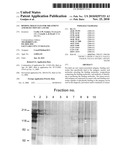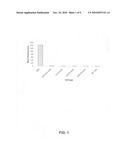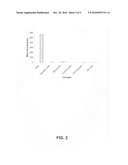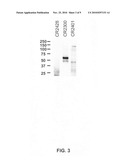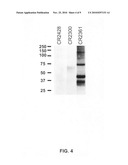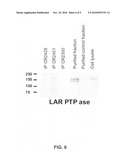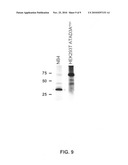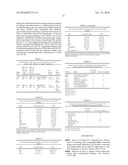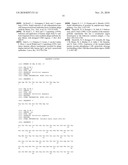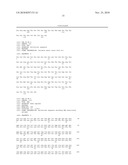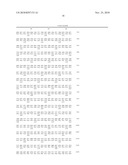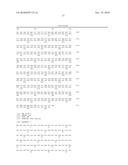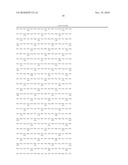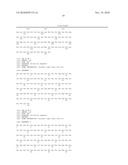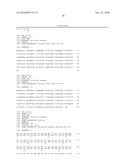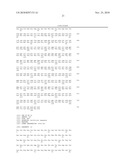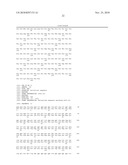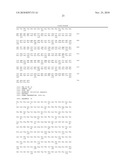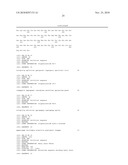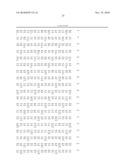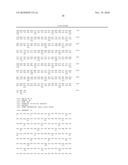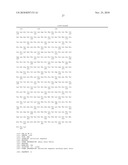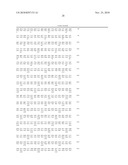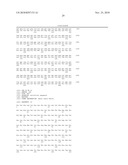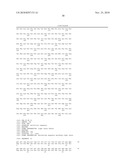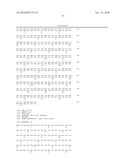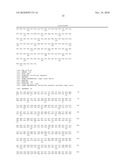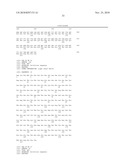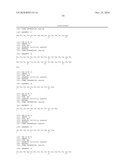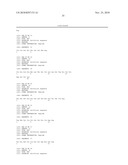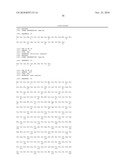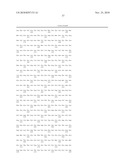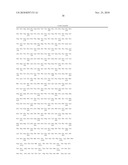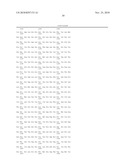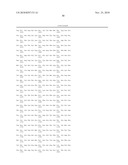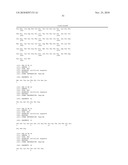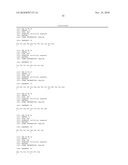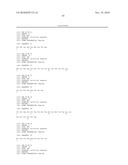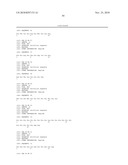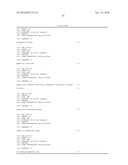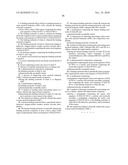Patent application title: Binding molecules for treatment and detection of cancer
Inventors:
Cecilia A.w. Geuijen (Moerkapelle, NL)
Cornelis A. De Kruif (El De Bilt, NL)
IPC8 Class: AA61K39395FI
USPC Class:
4241741
Class name: Immunoglobulin, antiserum, antibody, or antibody fragment, except conjugate or complex of the same with nonimmunoglobulin material binds eukaryotic cell or component thereof or substance produced by said eukaryotic cell (e.g., honey, etc.) cancer cell
Publication date: 2010-11-25
Patent application number: 20100297153
Claims:
1. A binding molecule able to bind to an antigen present on acute myeloid
leukemia (AML) cells, wherein the binding molecule comprises:at least a
heavy chain CDR3 region comprising the amino acid sequence of SEQ ID NO:1
or SEQ ID NO:2.
2. The binding molecule of claim 1, wherein the binding molecule comprises a heavy chain variable region comprising the amino acid sequence of SEQ ID NO:3 or SEQ ID NO:4.
3. The binding molecule of claim 1, wherein the binding molecule is human.
4. The binding molecule of claim 1, wherein the antigen is leukocyte antigen-related receptor protein tyrosine phosphatase or a polypeptide comprising the amino acid sequence of SEQ ID NO:6.
5. An immunoconjugate comprising the binding molecule of claim 1, and a tag.
6. A nucleic acid molecule encoding the binding molecule of claim 1.
7. A vector comprising at least one nucleic acid molecule of claim 6.
8. A host comprising at least one vector of claim 7.
9. The host of claim 8, wherein the host is a human cell.
10. A pharmaceutical composition comprising:the binding molecule of claim 1, anda pharmaceutically acceptable carrier.
11. A process of diagnosing acute myeloid leukemia (AML), wherein the improvement comprises:utilizing the binding molecule of claim 1, to diagnose AML.
12. A medicament comprising:the binding molecule of claim 1, anda pharmaceutically acceptable carrier.
13. A method of treating and/or preventing cancer in a subject, wherein the improvement comprises:administering the binding molecule of claim 1 to the subject to prevent or treat cancer in the subject.
14. The method according to claim 13, wherein the cancer is acute myeloid leukemia (AML).
15. A human binding molecule able to specifically bind to leukocyte antigen-related receptor protein tyrosine phosphatase.
16. The human binding molecule of claim 15, wherein the binding molecule comprises at least a heavy chain CDR3 region comprising the amino acid sequence of SEQ ID NO:1.
17. The human binding molecule of claim 15, wherein the binding molecule has specific immunoreactivity with acute myeloid leukemia (AML) subtypes M0, M1/2 and M3.
18. A medicament comprising the human binding molecule of claim 15, anda pharmaceutically acceptable carrier.
19. A composition for detecting, preventing, and/or treating, acute myeloid leukemia (AML), the composition comprising:the human binding molecule of claim 15.
20. A method of detecting, treating and/or preventing acute myeloid leukemia (AML) subtypes M0, M1/2 and M3 in a subject, wherein the improvement comprises:utilizing the human binding molecule of claim 17 for the detection, prevention, and/or treatment, of acute myeloid leukemia (AML) subtypes M0, M1/2 and M3 in the subject.
21. A pharmaceutical composition comprising:a polypeptide comprising the amino acid sequence of SEQ ID NO:6 or a nucleic acid molecule comprising the nucleotide sequence of SEQ ID NO:5, anda pharmaceutically acceptable carrier.
22. A binding molecule able to specifically bind a polypeptide comprising the amino acid sequence of SEQ ID NO:6.
23. A medicament comprising:a polypeptide comprising the amino acid sequence of SEQ ID NO:6, a nucleic acid molecule encoding a polypeptide comprising the amino acid sequence of SEQ ID NO:6, or the binding molecule of claim 22, anda pharmaceutically acceptable carrier.
24. A method of detecting, treating and/or preventing cancer in a subject, wherein the improvement comprises:utilizing a polypeptide comprising the amino acid sequence of SEQ ID NO:6, a nucleic acid molecule encoding a polypeptide comprising the amino acid sequence of SEQ ID NO:6 or the binding molecule of claim 22 for the detection, prevention, and/or treatment of the cancer.
25. The method according to claim 24, wherein the cancer is acute myeloid leukemia (AML).
Description:
CROSS-REFERENCE TO RELATED APPLICATIONS
[0001]This application is a continuation of co-pending U.S. patent application Ser. No. 11/665,102, filed Apr. 10, 2007, which is a national phase entry under 35 U.S.C. §371 of International Patent Application PCT/EP2005/055163, filed Oct. 11, 2005, published in English as International Patent Publication WO 2006/040322 A1 on Apr. 20, 2006, which claims the benefit under Article 8 of the Patent Cooperation Treaty to European Patent Application Serial No. 04104999.0, filed Oct. 12, 2004, and to U.S. Provisional Patent Application Ser. No. 60/618,332, filed Oct. 12, 2004, the entire disclosure of each of which is hereby incorporated herein by this reference.
TECHNICAL FIELD
[0002]The invention relates to the field of medicine. The invention in particular relates to binding molecules capable of specifically binding to cancer-associated antigens. The binding molecules are useful in the prevention, treatment and detection of cancer.
BACKGROUND DESCRIBED HEREIN
[0003]Cancer describes a class of diseases characterized by the uncontrolled growth of aberrant cells. It is the second leading cause of human death next to coronary disease. Worldwide, millions of people die from cancer every year. In the United States alone, cancer causes the death of well over a half million people each year, with some 1.4 million new cases diagnosed per year.
[0004]One form of cancer, accounting for about 3% of all cancers in the United States of America, is leukemia. This malignant disease is characterized by an abnormal proliferation of white blood cells which can be detected in the peripheral blood and/or bone marrow. Leukemia can be broadly classified into acute and chronic leukemia. Acute leukemia can be subclassified into myeloid and lymphoid leukemia in a variety of ways, including cell morphology and cytochemistry.
[0005]Acute myeloid leukemia (AML) is the most common form of leukemia accounting for about 50% of all leukemia cases and even 85% of all acute leukemia cases involving adults.
[0006]The standard treatment regime for AML is chemotherapy, which often includes an anthracycline. This results in a 70% complete remission (CR) rate in AML patients. Anthracycline therapy, however, is associated with severe side effects, including myelosuppression and dose-limiting cardiotoxicity, as well as a significant incidence of relapse. Less than 20% of CR patients survive in the long term. Relapsed AML disease exhibits multiple drug resistance (MDR), making the relapsed disease frequently refractory to further treatment with a variety of chemotherapeutic agents, including drugs.
[0007]In the light thereof, therapies for AML have been developed. Some therapies make use of antibodies capable of binding to AML-associated antigens such as CD33 or CD45 (see, WO 2004/043344). Although AML-associated antigens have been described, there is still a great need for new AML antigens useful in antibody and other biological therapies. In addition, there is a corresponding need for AML-associated antigens which may be useful as markers for antibody-based diagnostic and imaging methods, hopefully leading to the development of earlier diagnosis and greater prognostic precision.
SUMMARY DESCRIBED HEREIN
[0008]Described are new tumor target antigens for antibody-based prophylaxis and associated therapies. In particular, antigens associated with AML are provided. Furthermore, several binding molecules capable of binding to the tumor-associated antigens have been identified and obtained by using phage display technology. Furthermore, methods of producing these binding molecules and the use of the binding molecules in diagnosis, prevention and treatment of neoplastic disorders and diseases, in particular AML, have been described.
DESCRIPTION OF THE FIGURES
[0009]FIG. 1 shows the binding intensity (depicted in mean fluorescence) of the phage antibody SC02-401 to AML in relation to the binding intensity of the phage antibody to different cell populations in peripheral blood of a healthy donor.
[0010]FIG. 2 shows the binding intensity (depicted in mean fluorescence) of the phage antibody SC02-361 to AML in relation to the binding intensity of the phage antibody to different cell populations in peripheral blood of a healthy donor.
[0011]FIG. 3 shows an immunoblot of a LS174T cell lysate immunoprecipitated with a negative control IgG1 (CR2428; left lane), a positive control IgG1 directed against CD46 (CR2300; middle lane), or IgG1 CR2401 (right lane). On the left side of the blot molecular weight markers are indicated.
[0012]FIG. 4 shows an immunoblot of a NB4 cell lysate immunoprecipitated with a negative control IgG1 (CR2428; left lane), a positive control IgG1 directed against CD46 (CR2300; middle lane), or IgG1 CR2361 (right lane). On the left side of the blot molecular weight markers are indicated.
[0013]FIG. 5 shows a silver stained SDS-PAGE gel of the proteins eluting from an affinity column of CR2401. The arrow indicates the protein of interest (150 kDa) specifically released from the column in fraction 8-10. The asterisk indicates two protein bands somewhat smaller than 150 kDa. On the left side of the blot molecular weight markers are indicated.
[0014]FIG. 6 shows an immunoblot using a murine anti-LAR PTP antibody. On the left side the molecular weight markers are indicated. From left to right are shown, an immunoprecipitate of the negative control antibody CR2428, an immunoprecipitate of the antibody CR2401, an immunoprecipitate of the positive control antibody CR2300, a purified fraction, a purified control fraction and a complete LS174T cell lysate.
[0015]FIG. 7 shows a silver stained SDS-PAGE gel of the proteins eluting from an affinity column of CR2361. The arrows indicate the proteins of interest (30, 40, 75 and 150 kDa; E, F, G and H, respectively) specifically released from the column in fraction 9-12. On the left side the molecular weight markers are indicated.
[0016]FIG. 8 shows immunoblots of HEK93T cells transfected with ATAD3A, mycATAD3A and ATAD3Amyc constructs (right, left and middle part of blot, respectively). Cells were lysed and cell lysates obtained were biotinylated and immunoprecipitated with the negative control antibody CR2428, the positive control antibody CR2300 and antibody CR2361. Immunoblots were developed with anti-myc. On the left side the molecular weight markers are shown.
[0017]FIG. 9 shows an immunoblot of a cell surface biotinylated NB4 cell lysate immunoprecipitated with CR2361 (left lane) and a complete cell lysate of HEK293T cells transfected with ATAD3Amyc (right lane). On the left side of the blot molecular weight markers are indicated.
DETAILED DESCRIPTION
[0018]Encompassed are binding molecules capable of binding to an antigen present on tumor cells, such as AML cells. As used herein the term "acute myeloid leukemia (AML)" is characterized by an uncontrolled proliferation of progenitor cells of myeloid origin including, but not limited to, myeloid progenitor cells, myelomonocytic progenitor cells, and immature megakaryoblasts. Subtypes of AML according to the FAB classification include FAB-M0, FAB-M1, FAB-M2, FAB-M3, FAB-M4, FAB-M5, FAB-M6 and FAB-M7.
[0019]The described binding molecules may be human binding molecules. They can be intact immunoglobulin molecules, such as polyclonal or monoclonal antibodies, such as chimeric, humanized or in particular human monoclonal antibodies, or the binding molecules can be antigen-binding fragments including, but not limited to, Fab, F(ab'), F(ab')2, Fv, dAb, Fd, complementarity determining region (CDR) fragments, single-chain antibodies (scFv), bivalent single-chain antibodies, diabodies, triabodies, tetrabodies, and (poly)peptides that contain at least a fragment of an immunoglobulin that is sufficient to confer specific antigen binding to the (poly)peptides. The term "binding molecule," as used herein also includes the immunoglobulin classes and subclasses known in the art. Depending on the amino acid sequence of the constant domain of their heavy chains, binding molecules can be divided into the five major classes of intact antibodies: IgA, IgD, IgE, IgG, and IgM, and several of these may be further divided into subclasses (isotypes), e.g., IgA1, IgA2, IgG 1, IgG2, IgG3 and IgG4. The methods of production of antibodies are well known in the art and are described, for example, in Antibodies: A Laboratory Manual, edited by E. Harlow and D. Lane (1988), Cold Spring Harbor Laboratory, Cold Spring Harbor, N.Y., which is incorporated herein by reference.
[0020]The binding molecules can be used in non-isolated or isolated form. Furthermore, the binding molecules can be used alone or in a mixture comprising at least one binding molecule (or variant or fragment thereof). In other words, the binding molecules can be used in combination, e.g., as a pharmaceutical composition comprising two or more binding molecules or fragments thereof. For example, binding molecules having different, but complementary, activities can be combined in a single therapy to achieve a desired therapeutic or diagnostic effect, but alternatively, binding molecules having identical activities can also be combined in a single therapy to achieve a desired therapeutic or diagnostic effect. The mixture may further comprise at least one other therapeutic agent. Typically, the binding molecules can bind to their binding partners, i.e., the AML-associated antigens described herein, with an affinity constant (Kd-value) that is lower than 0.2*10-4M, 1.0*10-5 M, 1.0*10-6 M, 1.0*10-7 M, preferably lower than 1.0*10-8 M, more preferably lower than 1.0*10-9 M, more preferably lower than 1.0*10-10 M, even more preferably lower than 1.0*10-11 M, and in particular lower than 1.0*10-12 M. The affinity constants can vary for antibody isotypes. For example, affinity binding for an IgM isotype refers to a binding affinity of at least about 1.0*10-7 M. Affinity constants can be measured using surface plasmon resonance, i.e., an optical phenomenon that allows for the analysis of real-time biospecific interactions by detection of alterations in protein concentrations within a biosensor matrix, for example, using the BIAcore system (Pharmacia Biosensor AB, Uppsala, Sweden).
[0021]The binding molecules may bind to the AML-associated antigens described herein in soluble form or may bind to the AML-associated antigens described herein bound or attached to a carrier or substrate, e.g., microtiter plates, membranes and beads, etc. Carriers or substrates may be made of glass, plastic (e.g., polystyrene), polysaccharides, nylon, nitrocellulose, or TEFLON®, etc. The surface of such supports may be solid or porous and of any convenient shape. Furthermore, the binding molecules may bind to the AML-associated antigens in purified or non-purified form and/or in isolated or non-isolated form. Preferably, the binding molecules are capable of binding to the antigens when they are associated with cells, such as a human cells positive for the antigen, e.g., AML cells or cells transfected with the AML-associated antigens described herein, or portions or parts of these cells comprising the AML-associated antigens or a fragment thereof such as the extracellular part of the antigens. As the AML-associated antigens according to the invention are overexpressed by tumor cells as compared to normal cells of the same tissue type, the binding molecules according to the invention can be used to selectively target the tumor cells. In particular, the AML-associated antigens according to the invention are overexpressed by AML cells as compared to normal blood cells.
[0022]The binding molecules described herein, which stay bound to the surface upon binding to the antigens present on the surface of target cells, such as AML cells, may be used in the format of naked binding molecules to support possible effector functions of antibody-dependent cellular cytotoxicity (ADCC) and/or complement-dependent cytotoxicity (CDC). Assays to distinguish ADCC or CDC are well known to the person skilled in the art. The described naked antibodies may also induce apoptosis of target cells in another way than by means of ADCC or CDC. Alternatively, they may internalize upon binding to the AML-associated antigens described herein. Internalization of binding molecules can be assayed by techniques known to the person skilled in the art.
[0023]In certain embodiments, the binding molecules comprise at least a CDR3 region, preferably a heavy chain CDR3 region, comprising the amino acid sequence of SEQ ID NO:1 or SEQ ID NO:2.
[0024]In another embodiment, the binding molecules comprise a heavy chain variable region comprising the amino acid sequence of SEQ ID NO:3 or SEQ ID NO:4.
[0025]In yet a further embodiment, the binding molecules comprise a heavy chain variable region comprising the amino acid sequence shown in SEQ ID NO:3 and a light chain variable region comprising the amino acid sequence of SEQ ID NO:7, or a heavy chain variable region comprising the amino acid sequence shown in SEQ ID NO:4 and a light chain variable region comprising the amino acid sequence of SEQ ID NO:8.
[0026]Another aspect described herein includes functional variants of binding molecules or fragments thereof as defined herein. Molecules are considered to be functional variants of a binding molecule according to the invention, if the variants are capable of competing for specifically binding to the AML-associated antigens described herein with the parent binding molecules. In other words, when the functional variants are still capable of binding to the AML-associated antigens or a portion thereof. Functional variants include, but are not limited to, derivatives that are substantially similar in primary structural sequence, but which contain e.g., in vitro or in vivo modifications, chemical and/or biochemical, that are not found in the parent binding molecule. Such modifications are well known to the skilled artisan.
[0027]Alternatively, functional variants can be binding molecules comprising an amino acid sequence containing substitutions, insertions, deletions or combinations thereof of one or more amino acids compared to the amino acid sequences of the parent binding molecules. Furthermore, functional variants can comprise truncations of the amino acid sequence at either or both the amino or carboxy termini. Functional variants according to the invention may have the same or different, either higher or lower, binding affinities compared to the parent binding molecule but are still capable of binding to the AML-associated antigens described herein. For instance, functional variants according to the invention may have increased or decreased binding affinities for the AML-associated antigens described herein compared to the parent binding molecules. Preferably, the amino acid sequences of the variable regions, including, but not limited to, framework regions, hypervariable regions, in particular the CDR3 regions, are modified. Functional variants intended to fall within the scope described herein have at least about 50% to about 99%, preferably at least about 60% to about 99%, more preferably at least about 70% to about 99%, even more preferably at least about 80% to about 99%, most preferably at least about 90% to about 99%, in particular at least about 95% to about 99%, and in particular, at least about 97% to about 99% amino acid sequence homology with the parent binding molecules as defined herein. Computer algorithms such as inter alia Gap or Bestfit known to a person skilled in the art can be used to optimally align amino acid sequences to be compared and to define similar or identical amino acid residues. Functional variants can be obtained by altering the parent binding molecules or parts thereof by general molecular biology methods known in the art including, but not limited to, error prone PCR, oligonucleotide-directed mutagenesis and site-directed mutagenesis.
[0028]In an embodiment the AML-associated antigen is leukocyte antigen-related receptor protein tyrosine phosphatase (LAR PTP). LAR PTP is a prototype of a family of transmembrane phosphatases whose extracellular domains are composed of three Ig and several fibronectin type III domains (Streuli et al. 1988). LAR PTP is expressed in cells of many different lineages including epithelial cells, smooth muscle cells and cardiac myocytes and increased levels of LAR PTP expression and differential patterns of extracellular alternative splicing were found in breast cancer cell lines and pheochromocytoma tumor tissue.
[0029]Another aspect described herein pertains to a human binding molecule as herein defined capable of specifically binding to LAR PTP or the extracellular part thereof. The amino acid sequence of LAR PTP is shown in SEQ ID NO:40. The extracellular part of the protein consists of amino acids 1-1259 (Streuli et al., 1992). In certain embodiments, the human binding molecule specifically binding to LAR PTP comprises at least a heavy chain CDR3 region comprising the amino acid sequence of SEQ ID NO:1. The binding molecule capable of specifically binding to LAR PTP can be used in indications wherein LAR PTP has been suggested to play a role such as inter alia obesity, Type II diabetes, and tumors. As LAR PTP is overexpressed in AML cells the binding molecule capable of specifically binding to LAR PTP can be used as a medicament, in detection, prevention and/or treatment of AML. The binding molecules described herein have specific immunoreactivity with AML subtypes M0, M1/2 and M3 and can thus advantageously be used as a medicament, in detection, prevention and/or treatment of these specific AML subtypes.
[0030]In another embodiment, the AML-associated antigen is a polypeptide comprising the amino acid sequence of SEQ ID NO:6. This protein has been called ATAD3A. It contains a potential ATP-ase region from amino acids 347-467 and potentially belongs to the AAA-superfamily of ATP-ases. In general, ATP-ases are associated with a wide variety of cellular activities, including membrane fusion, proteolysis, and DNA replication. The invention further provides that the polypeptide is overexpressed in tumors, particularly in AML. The polypeptide is expressed by all AML subtypes.
[0031]An aspect described herein is concerned with a nucleic acid molecule encoding the polypeptide comprising the amino acid sequence of SEQ ID NO:6. In a specific embodiment the nucleic acid molecule comprises the nucleotide sequence of SEQ ID NO:5.
[0032]Another aspect described herein is concerned with a pharmaceutical composition comprising a polypeptide comprising the amino acid sequence of SEQ ID NO:6 or a nucleic acid molecule encoding the polypeptide. The pharmaceutical composition further comprises a pharmaceutically acceptable carrier. Such a composition could be used as a vaccine.
[0033]In yet another embodiment, provided is a binding molecule as herein defined capable of specifically binding to a polypeptide comprising the amino acid sequence of SEQ ID NO:6. The polypeptide comprising the amino acid sequence of SEQ ID NO:6, a pharmaceutical composition comprising this polypeptide or nucleic acid molecule encoding this polypeptide or binding molecule specifically binding to this polypeptide can be used as a medicament for inter alia the detection, prevention and/or treatment of cancer, in particular for the detection, prevention and/or treatment of AML.
[0034]Naturally occurring truncated or secreted forms, naturally occurring variant forms (e.g., alternatively spliced forms) and naturally occurring allelic variants of the AML-associated antigens described herein are also a part described herein. Binding molecules described herein may also be capable of specifically binding to non-naturally occurring variants or analogues of these antigens as long as the modifications do not abolish the binding of the binding molecules to the antigens.
[0035]A nucleic acid molecule encoding the polypeptide as described above, preferably comprising the amino acid sequence of SEQ ID NO:6, preferably comprises the nucleotide sequence as shown in SEQ ID NO:5. The nucleic acid molecule may be used as a vaccine or for making a vaccine.
[0036]In yet a further aspect, described are immunoconjugates, i.e., molecules comprising at least one binding molecule as described above and further comprising at least one tag, such as a therapeutic moiety that inhibits or prevents the function of cells and/or causes destruction of cells. Also contemplated are mixtures of immunoconjugates or mixtures of at least one immunoconjugates and another molecule, such as a therapeutic or diagnostic agent or another binding molecule or immunoconjugate. In a further embodiment, the immunoconjugates described herein may comprise more than one tag. These tags can be the same or distinct from each other and can be joined/conjugated non-covalently to the binding molecules. The tags can also be joined/conjugated directly to the binding molecules through covalent bonding. Alternatively, the tags can be joined/conjugated to the binding molecules by means of one or more linking compounds. Techniques for conjugating tags to binding molecules, are well known, see, e.g., Arnon et al., "Monoclonal Antibodies For Immunotargeting Of Drugs In Cancer Therapy," p. 243-256 in Monoclonal Antibodies And Cancer Therapy (1985), edited by Reisfeld et al., A. R. Liss, Inc.; Hellstrom et al., "Antibodies For Drug Delivery," p. 623-653 in Controlled Drug Delivery, 2nd edition (1987), edited by Robinson et al., Marcel Dekker, Inc.; Thorpe, "Antibody Carriers Of Cytotoxic Agents," p. 475-506 in Cancer Therapy: A Review, in Monoclonal Antibodies '84: Biological And Clinical Applications (1985), edited by Pinchera et al.; "Analysis, Results, and Future Prospective of the Therapeutic Use of Radiolabeled Antibody in Cancer Therapy," p. 303-316 in Monoclonal Antibodies For Cancer Detection And Therapy (1985), edited by Baldwin et al., Academic Press.
[0037]Tags include, but are not limited to, toxic substances, radioactive substances, liposomes, enzymes, polynucleotide sequences, plasmids, proteins, peptides or combinations thereof. Toxic substances include, but are not limited to, cytotoxic agents, such as small molecule toxins or chemotherapeutic agents, or enzymatically active toxins of bacterial, fungal, plant or animal origin, or fragments thereof. In general, suitable chemotherapeutic agents are described in Remington's Pharmaceutical Sciences, 18th edition (1990), edited by A. R. Gennaro, Mack Publishing Co., Philadelphia; and in Goodman and Gilman's The Pharmacological Basis of Therapeutics, 7th edition (1985), edited by A. G. Gilman, L. S. Goodman, T. W. Rall and F. Murad, MacMillan Publishing Co., New York. Suitable chemotherapeutic agents that are still in the experimental phase are known to those of skill in the art and might also be used as toxic substances in the invention.
[0038]Fusion proteins comprising enzymatically active toxins and binding molecules of the immunoconjugate described herein can be produced by methods known in the art such as, e.g., recombinantly by constructing nucleic acid molecules comprising nucleotide sequences encoding the binding molecules in frame with nucleotide sequences encoding the enzymatically active toxin and then expressing the nucleic acid molecules. Alternatively, fusion proteins can be produced chemically by conjugating, directly or indirectly via for instance a linker, binding molecules as defined herein to enzymatically active toxins. Immunoconjugates comprising enzymes may be useful in antibody-directed enzyme-prodrug therapy (ADEPT).
[0039]Also contemplated are binding molecules of the immunoconjugate described herein that are labeled with radionuclides. The skilled person knows suitable radionuclides. The choice of radionuclide will be dependent on many factors such as, e.g., the type of disease to be treated, the stage of the disease to be treated, the patient to be treated and the like. Binding molecules can be attached to radionuclides directly or indirectly via a chelating agent by methods well known in the art.
[0040]In another embodiment, the binding molecules of the immunoconjugate described herein can be conjugated to liposomes to produce so called immunoliposomes. A liposome may be conjugated to one or more binding molecules, the binding molecules being either the same or different. A variety of methods are available for preparing liposomes. These methods are well known in the art and include, but are not limited to, sonication, extrusion, high pressure/homogenization, microfluidization, detergent dialysis, calcium induced fusion of small liposome vesicles, and ether infusion methods. The liposomes may be multilamellar vesicles, but preferably the liposomes are unilamellar vesicles such as small unilamellar (200-500 Å) or large unilamellar vesicles (500-5000 Å). The drugs that can be loaded into liposomes include, but are not limited to, the toxic substances mentioned above. Liposomes having loaded different drugs and different liposomes, each liposome having loaded one kind of drug, may be alternative embodiments of liposomes that can be used and these embodiments are therefore also contemplated in the invention. Binding molecules described herein may be attached at the surface of the liposomes or to the terminus of polymers such as polyethylene glycol that are grafted at the surface of the liposomes using conventional chemical coupling techniques.
[0041]In yet another embodiment, the binding molecules described herein may be linked to water-soluble, biodegradable polymers, such as for instance polymers of hydroxypropylmethacrylamine (HPMA).
[0042]In another aspect, the binding molecules described herein may be conjugated/attached to one or more antigens. These antigens may be antigens that are recognized by the immune system of a subject to whom the binding molecule-antigen conjugate is administered. The antigens may be identical, but may also be different. Conjugation methods for attaching the antigens and binding molecules are well known in the art and include, but are not limited to, the use of cross-linking agents.
[0043]Alternatively, the binding molecules as described herein can be conjugated to tags and be used for detection and/or analytical and/or diagnostic purposes. The tags used to label the binding molecules for those purposes depend on the specific detection/analysis/diagnosis techniques and/or methods used such as inter alia immunohistochemical staining of tissue samples, flow cytometric detection, scanning laser cytometric detection, fluorescent immunoassays, enzyme-linked immunosorbent assays (ELISAs), radioimmunoassays (RIAs), bioassays (e.g., growth inhibition assays), Western blotting applications, etc. The binding molecules described herein may also be conjugated to photoactive agents or dyes such as fluorescent and other chromogens or dyes to use the so obtained immunoconjugates in photoradiation, phototherapy, or photodynamic therapy.
[0044]When the immunoconjugates described herein are used for in vivo diagnostic use, the binding molecules can also be made detectable by conjugation to, e.g., magnetic resonance imaging (MRI) contrast agents, ultrasound contrast agents or to X-ray contrast agents, or by radioisotopic labeling.
[0045]Furthermore, the binding molecules or immunoconjugates described herein can also be attached to solid supports, which are particularly useful for immunoassays or purification of the binding partner. Such solid supports might be porous or nonporous, planar or nonplanar. The binding molecules can also, for example, usefully be conjugated to filtration media, such as NHS-activated Sepharose or CNBr-activated Sepharose for purposes of immunoaffinity chromatography. They can also usefully be attached to paramagnetic microspheres, typically by biotin-streptavidin interaction. The microspheres can be used for isolation of cells that express or display the AML-associated antigens or fragments thereof. As another example, the binding molecules described herein can usefully be attached to the surface of a microtiter plate for ELISA. It is clear to the skilled artisan that any of the tags described above can also be conjugated to the new antigens described herein.
[0046]Another aspect described herein concerns nucleic acid molecules as defined herein encoding binding molecules described herein. In yet another aspect, provided are nucleic acid molecules encoding at least the binding molecules specifically binding to the AML-associated antigens described above. In certain embodiments, the nucleic acid molecules are isolated or purified.
[0047]The skilled person will appreciate that functional variants of the nucleic acid molecules described herein are also intended to be a part described herein. Functional variants are nucleic acid sequences that can be directly translated, using the standard genetic code, to provide an amino acid sequence identical to that translated from the parent nucleic acid molecules. Preferably, the nucleic acid molecules encode binding molecules comprising a CDR3 region, preferably a heavy chain CDR3 region, comprising the amino acid sequence of SEQ ID NO:1 or SEQ ID NO:2. Even more preferably, the nucleic acid molecules encode binding molecules comprising a heavy chain variable region comprising the amino acid sequence of SEQ ID NO:3 or SEQ ID NO:4. In yet another embodiment, the nucleic acid molecules encode binding molecules comprising a heavy chain variable region comprising the amino acid sequence of SEQ ID NO:3 and a light chain variable region comprising the amino acid sequence of SEQ ID NO:7, or they encode a heavy chain variable region comprising the amino acid sequence of SEQ ID NO:4 and a light chain variable region comprising the amino acid sequence of SEQ ID NO:8. In a specific embodiment, the nucleic acid molecules encoding the binding molecules described herein comprise the nucleotide sequence of SEQ ID NO:9 or SEQ ID NO:10.
[0048]It is another aspect to provide vectors, e.g., nucleic acid constructs, comprising one or more nucleic acid molecules according to the invention. Vectors can be derived from plasmids; cosmids; phages; plant viruses; or animal viruses. Vectors can be used for cloning and/or for expression of the binding molecules described herein and might even be used for gene therapy purposes. Vectors comprising one or more nucleic acid molecules according to the invention operably linked to one or more expression regulating nucleic acid molecules are also covered by the invention. The choice of vector is dependent on the recombinant procedures followed and the host used. Introduction of vectors in host cells can be effected by inter alia calcium phosphate transfection, virus infection, DEAE-dextran mediated transfection, lipofectamine transfection or electroporation. Vectors may be autonomously replicating or may replicate together with the chromosome into which they have been integrated. Preferably, the vectors contain one or more selection markers. The choice of the markers may depend on the host cells of choice, although this is not critical to the invention as is well known to persons skilled in the art. Vectors comprising one or more nucleic acid molecules encoding the binding molecules as described above operably linked to one or more nucleic acid molecules encoding proteins or peptides that can be used to isolate the binding molecules are also covered by the invention.
[0049]Hosts containing one or more copies of the vectors mentioned hereinabove are an additional subject described herein. Preferably, the hosts are host cells. Host cells include, but are not limited to, cells of mammalian, plant, insect, fungal or bacterial origin. Bacterial cells include, but are not limited to, cells from Gram positive bacteria such as several species of the genera Bacillus, Streptomyces and Staphylococcus or cells of Gram negative bacteria such as several species of the genera Escherichia and Pseudomonas. In the group of fungal cells preferably yeast cells are used. Expression in yeast can be achieved by using yeast strains such as inter alia Pichia pastoris, Saccharomyces cerevisiae and Hansenula polymorpha. Furthermore, insect cells such as cells from Drosophila and Sf9 can be used as host cells. Besides that, the host cells can be plant cells. Transformed (transgenic) plants or plant cells are produced by known methods. Expression systems using mammalian cells such as Chinese Hamster Ovary (CHO) cells, COS cells, BHK cells or Bowes melanoma cells are preferred in the invention. Mammalian cells provide expressed proteins with posttranslational modifications that are most similar to natural molecules of mammalian origin. Since the invention deals with molecules that may have to be administered to humans, a completely human expression system would be particularly preferred. Therefore, even more preferably, the host cells are human cells. Examples of human cells are inter alia HeLa, 911, AT1080, A549, 293 and HEK293T cells. In preferred embodiments, the human producer cells comprise at least a functional part of a nucleic acid sequence encoding an adenovirus E1 region in expressible format. In even more preferred embodiments, the host cells are human retina cells and immortalized with nucleic acids comprising adenoviral E1 sequences such as 911 cells or the cell line deposited at the European Collection of Cell Cultures (ECACC), CAMR, Salisbury, Wiltshire SP4 OJG, Great Britain on 29 Feb. 1996 under number 96022940 and marketed under the trademark PER.C6® (PER.C6 is a registered trademark of Crucell Holland B. V.). For the purposes of this application "PER.C6" refers to cells deposited under number 96022940 or ancestors, passages up-stream or downstream as well as descendants from ancestors of deposited cells, as well as derivatives of any of the foregoing.
[0050]Production of recombinant proteins in host cells can be performed according to methods well known in the art. The use of the cells marketed under the trademark PER.C6® as a production platform for proteins of interest has been described in WO 00/63403, the disclosure of which is incorporated herein by reference in its entirety.
[0051]It is another aspect to provide a method of producing binding molecules or functional variants thereof, preferably human binding molecules or functional variants thereof. The method comprises the steps of a) culturing a host as described above under conditions conducive to the expression of the binding molecules, and b) optionally, recovering the expressed binding molecules. The expressed binding molecules can be recovered from the cell free extract, but preferably they are recovered from the culture medium. Methods to recover proteins, such as binding molecules, from cell free extracts or culture medium are well known to the man skilled in the art. Binding molecules as obtainable by the above described method are also a part described herein.
[0052]Alternatively, next to the expression in hosts, such as host cells, the binding molecules described herein can be produced synthetically by conventional peptide synthesizers or in cell free translation systems using RNAs derived from DNA molecules according to the invention. Binding molecule as obtainable by the above described synthetic production methods or cell free translation systems are also a part described herein. In addition, the above-mentioned methods of producing binding molecules can also be used to produce the AML-associated antigens described herein.
[0053]In yet another alternative embodiment, binding molecules according to the invention may be generated by transgenic non-human mammals. Protocols for immunizing non-human mammals are well established in the art. See Using Antibodies: A Laboratory Manual, edited by E. Harlow, D. Lane (1998), Cold Spring Harbor Laboratory, Cold Spring Harbor, N.Y.; and Current Protocols in Immunology, edited by J. E. Coligan, A. M. Kruisbeek, D. H. Margulies, E. M. Shevach, W. Strober (2001), John Wiley & Sons Inc., New York, the disclosures of which are incorporated herein by reference.
[0054]In a further aspect, provided is a method of identifying binding molecules, preferably human binding molecules such as human monoclonal antibodies or fragments thereof, or nucleic acid molecules and comprises the steps of a) contacting a phage library of binding molecules, preferably human binding molecules, with material comprising the AML-associated antigens described herein or fragments thereof, b) selecting at least once for a phage binding to the material comprising the AML-associated antigens described herein or fragments thereof, and c) separating and recovering the phage binding to the material comprising the AML-associated antigens described herein or fragments thereof. The selection step according to the invention is preferably performed in the presence of at least part of the AML-associated antigens described herein, e.g., cells transfected with expression plasmids of the AML-associated antigens, isolated AML-associated antigens, the extracellular part thereof, fusion proteins comprising such, and the like. In an embodiment the selection step is performed in the presence of AML cells. Prior to or concurrent with this selection step the phage library of binding molecules can be contacted to normal blood cells and/or tumor cell lines expressing the AML-associated antigens described herein. Phage display methods for identifying and obtaining binding molecules, e.g., antibodies, are by now well-established methods known by the person skilled in the art. They are, e.g., described in U.S. Pat. No. 5,696,108; Burton and Barbas, 1994; and de Kruif et al., 1995b. For the construction of phage display libraries, collections of human monoclonal antibody heavy and light chain variable region genes are expressed on the surface of bacteriophage, preferably filamentous bacteriophage, particles in, for example, single chain Fv (scFv) or in Fab format (see, de Kruif et al., 1995b). Large libraries of antibody fragment-expressing phages typically contain more than 1.0*109 antibody specificities and may be assembled from the immunoglobulin V regions expressed in the B-lymphocytes of immunized- or non-immunized individuals. Alternatively, phage display libraries may be constructed from immunoglobulin variable regions that have been partially assembled in vitro to introduce additional antibody diversity in the library (semi-synthetic libraries). For example, in vitro assembled variable regions contain stretches of synthetically produced, randomized or partially randomized DNA in those regions of the molecules that are important for antibody specificity, e.g., CDR regions. Antigen-specific phage antibodies can be selected from the library by immobilizing target antigens on a solid phase and subsequently exposing the target antigens to a phage library to allow binding of phages expressing antibody fragments specific for the solid phase-bound antigen. Non-bound phages are removed by washing and bound phages eluted from the solid phase for infection of Escherichia coli (E. coli) bacteria and subsequent propagation. Multiple rounds of selection and propagation are usually required to sufficiently enrich for phages binding specifically to the target antigen. Phages may also be selected for binding to complex antigens such as complex mixtures of proteins or whole cells such as cells transfected with antigen expression plasmids or cells naturally expressing the AML-associated antigens described herein. Selection of antibodies on whole cells has the advantage that target antigens are presented in their native configuration, i.e., unperturbed by possible conformational changes that might have been introduced in the case where an antigen is immobilized to a solid phase. Antigen-specific phage antibodies can be selected from the library by incubating a cell population of interest, expressing known and unknown antigens on their surface, with the phage antibody library to let, for example, the scFv or Fab part of the phage bind to the antigens on the cell surface. After incubation and several washes to remove unbound and loosely attached phages, the cells of interest are stained with specific fluorescent labeled antibodies and separated on a Fluorescent Activated Cell Sorter (FACS). Phages that have bound with their scFv or Fab part to these cells are eluted and used to infect E. coli to allow amplification of the new specificity. Generally, one or more selection rounds are required to separate the phages of interest from the large excess of non-binding phages. Monoclonal phage preparations can be analyzed for their specific staining patterns and allowing identification of the antigen being recognized (De Kruif et al., 1995a). The phage display method can be extended and improved by subtracting non-relevant binders during screening by addition of an excess of non-target molecules that are similar, but not identical, to the target, and thereby strongly enhance the chance of finding relevant binding molecules (This process is referred to as the MABSTRACT® process. MABSTRACT® is a registered trademark of Crucell Holland B. V., see also U.S. Pat. No. 6,265,150, which is incorporated herein by reference).
[0055]In yet a further aspect, provided is a method of obtaining a binding molecule or a nucleic acid molecule according to the invention, wherein the method comprises the steps of a) performing the above described method of identifying binding molecules, preferably human binding molecules such as human monoclonal antibodies or fragments thereof according to the invention, or nucleic acid molecules according to the invention, and b) isolating from the recovered phage the human binding molecule and/or the nucleic acid encoding the human binding molecule. Once a new monoclonal phage antibody has been established or identified with the above mentioned method of identifying binding molecules or nucleic acid molecules encoding the binding molecules, the DNA encoding the scFv or Fab can be isolated from the bacteria or phages and combined with standard molecular biological techniques to make constructs encoding bivalent scFvs or complete human immunoglobulins of a desired specificity (e.g., IgG, IgA or IgM). These constructs can be transfected into suitable cell lines and complete human monoclonal antibodies can be produced (see, Huls et al., 1999; Boel et al., 2000).
[0056]In a further aspect, provided are compositions comprising at least one binding molecule, at least one functional variant or fragment thereof, at least one immunoconjugate according to the invention or a combination thereof. In another aspect, provided are compositions comprising the new AML-associated antigens described herein. In addition to that, the compositions may comprise inter alia stabilizing molecules, such as albumin or polyethylene glycol, or salts. If necessary, the binding molecules or antigens described herein may be coated in or on a material to protect them from the action of acids or other natural or non-natural conditions that may inactivate the binding molecules.
[0057]In yet a further aspect, provided are compositions comprising at least one nucleic acid molecule as defined in the invention. The compositions may comprise aqueous solutions such as aqueous solutions containing salts (e.g., NaCl or salts as described above), detergents (e.g., SDS) and/or other suitable components.
[0058]Furthermore, the invention pertains to pharmaceutical compositions comprising at least one binding molecule according to the invention, at least one functional variant or fragment thereof, at least one immunoconjugate according to the invention, at least one composition according to the invention, or combinations thereof. The invention also provides a pharmaceutical composition comprising the AML-associated antigens described herein. The pharmaceutical composition described herein further comprises at least one pharmaceutically acceptable carrier/excipient. A pharmaceutical composition according to the invention can further comprise at least one other therapeutic, prophylactic and/or diagnostic agent.
[0059]Typically, pharmaceutical compositions must be sterile and stable under the conditions of manufacture and storage. The binding molecules, variant or fragments thereof, immunoconjugates, nucleic acid molecules, compositions or antigens described herein can be in powder form for reconstitution in the appropriate pharmaceutically acceptable excipient before or at the time of delivery. In the case of sterile powders for the preparation of sterile injectable solutions, the preferred methods of preparation are vacuum drying and freeze-drying (lyophilization) that yield a powder of the active ingredient plus any additional desired ingredient from a previously sterile-filtered solution thereof.
[0060]Alternatively, the binding molecules, variant or fragments thereof, immunoconjugates, nucleic acid molecules or compositions described herein can be in solution and the appropriate pharmaceutically acceptable excipient can be added and/or mixed before or at the time of delivery to provide a unit dosage injectable form. Preferably, the pharmaceutically acceptable excipient used in the invention is suitable to high drug concentration, can maintain proper fluidity and, if necessary, can delay absorption.
[0061]The choice of the optimal route of administration of the pharmaceutical compositions will be influenced by several factors including the physico-chemical properties of the active molecules within the compositions, the urgency of the clinical situation and the relationship of the plasma concentrations of the active molecules to the desired therapeutic effect. The routes of administration can be divided into two main categories, oral and parenteral administration. The preferred administration route is intravenous.
[0062]The binding molecules, such as the human binding molecules such as human monoclonal antibodies according to the invention, the variants or fragments thereof, the immunoconjugates according to the invention, the nucleic acid molecules according to the invention, the compositions according to the invention or the pharmaceutical compositions according to the invention can be used as medicaments. They can inter alia be used in the diagnosis, prevention, treatment, or combination thereof, of cancer. The cancer may be AML, however other tumors, such as tumors wherein the new antigens described herein are overexpressed, can also be prevented, treated and/or diagnosed. The binding molecules described herein are suitable for treatment of yet untreated patients suffering from cancer, patients who have been or are treated and are in remission or are not in remission, and patients with a recurrent/refractory cancer. The binding molecules described herein may even be used in the prophylaxis of cancer. In addition, the novel antigens described herein or pharmaceutical compositions comprising such may be used in the diagnosis, prevention, treatment, or combination thereof, of cancer. Preferably, the cancer a tumor wherein the novel antigens are overexpressed such as AML.
[0063]The above mentioned molecules or compositions may be employed in conjunction with other molecules useful in diagnosis, prevention and/or treatment. They can be used in vitro, ex vivo or in vivo. The molecules are typically formulated in the compositions and pharmaceutical compositions described herein in a prophylactically, therapeutically or diagnostically effective amount. Dosage regimens can be adjusted to provide the optimum desired response (e.g., a therapeutic response). The molecules and compositions according to the invention are preferably sterile. Methods to render these molecules and compositions sterile are well known in the art. The other molecules useful in diagnosis, prevention and/or treatment can be administered in a similar dosage regimen as proposed for the binding molecules described herein. If the other molecules are administered separately, they may be administered to a subject with cancer prior (e.g., 2 minutes, 5 minutes, 10 minutes, 15 minutes, 30 minutes, 45 minutes, 60 minutes, 2 hours, 4 hours, 6 hours, 8 hours, 10 hours, 12 hours, 14 hours, 16 hours, 18 hours, 20 hours, 22 hours, 24 hours, 2 days, 3 days, 4 days, 5 days, 7 days, 2 weeks, 4 weeks or 6 weeks before) to, concomitantly with, or subsequent (e.g., 2 minutes, 5 minutes, 10 minutes, 15 minutes, 30 minutes, 45 minutes, 60 minutes, 2 hours, 4 hours, 6 hours, 8 hours, 10 hours, 12 hours, 14 hours, 16 hours, 18 hours, 20 hours, 22 hours, 24 hours, 2 days, 3 days, 4 days, 5 days, 7 days, 2 weeks, 4 weeks or 6 weeks after) to the administration of one or more of the binding molecules or pharmaceutical compositions described herein. The dosing regimen is usually sorted out during clinical trials in human patients.
[0064]Human binding molecules and pharmaceutical compositions comprising the human binding molecules are particularly useful, and often preferred, when to be administered to human beings as in vivo diagnostic or therapeutic agents, since recipient immune response to the administered antibody will often be substantially less than that occasioned by administration of a monoclonal murine, chimeric or humanized binding molecule.
[0065]Alternatively, cells that are genetically engineered to express the binding molecules described herein are administered to patients in vivo. Such cells may be obtained from an animal or patient or an MHC compatible donor and can include, but are not limited to fibroblasts, bone marrow cells, blood cells (e.g., lymphocytes), adipocytes, muscle cells, endothelial cells, etc. The cells are genetically engineered in vitro using recombinant DNA techniques to introduce the nucleic acid molecules described herein into the cells. Preferably, the binding molecules are secreted from the cells. The engineered cells which express and preferably secrete the binding molecules as described herein can be introduced into the patient, for example, systemically, e.g., in the circulation, or intraperitoneally. In other embodiments, the cells can be incorporated into a matrix or can be encapsulated and implanted in the body. In a gene therapy setting the binding molecules may be administered in the form of a vector capable of infecting cells of the host, coding for a binding molecule according to the invention.
[0066]In another aspect, described is the use of binding molecules, preferably human binding molecules such as human monoclonal antibodies, fragments or variants thereof, immunoconjugates according to the invention, nucleic acid molecules according to the invention, compositions or pharmaceutical compositions according to the invention in the preparation of a medicament for the diagnosis, prophylaxis, treatment, or combination thereof, of cancer such as AML.
[0067]Kits comprising at least one binding molecule, preferably human binding molecule such as human monoclonal antibody according to the invention, at least one variant or fragment thereof, at least one immunoconjugate, at least one nucleic acid molecule, at least one composition, at least one pharmaceutical composition, at least one vector, at least one host, or a combination thereof are also a part hereof. Optionally, the above described kits also comprise an AML-associated antigen described herein. Optionally, the above described components of the kits described herein are packed in suitable containers and labeled for diagnosis and/or treatment of the indicated conditions. The above-mentioned components may be stored in unit or multi-dose containers. The kit may further comprise more containers comprising a pharmaceutically acceptable buffer. It may further include other materials desirable from a commercial and user standpoint, including other buffers, diluents, filters, needles, syringes, culture medium for one or more of the suitable hosts. Associated with the kits can be instructions customarily included in commercial packages of therapeutic or diagnostic products, that contain information about, for example, the indications, usage, dosage, manufacture, administration, contraindications and/or warnings concerning the use of such therapeutic or diagnostic products.
[0068]Furthermore, described is a method of screening a binding molecule or a functional variant or fragment thereof for specific binding to the same epitope of an AML-associated antigens described herein or fragment thereof, as the epitope bound by the binding molecule according to the invention, wherein the method comprises the steps of (a) contacting a binding molecule (or a functional variant or fragment thereof) to be screened, a binding molecule (or functional fragment or variant thereof) according to the invention and an AML-associated antigen described herein (or a fragment thereof comprising the antigenic determinant), (b) measure if the binding molecule (or functional variant or fragment thereof) to be screened is capable of competing for specifically binding to an AML-associated antigen described herein (or fragment thereof comprising the antigenic determinant) with the binding molecule described herein. Binding molecules identified by these competition assays ("competitive binding molecules" or "cross-reactive binding molecules") include, but are not limited to, antibodies, antibody fragments and other binding agents that bind to an epitope or binding site bound by the reference binding molecule, i.e., a binding molecule described herein, as well as antibodies, antibody fragments and other binding agents that bind to an epitope or binding site sufficiently proximal to an epitope bound by the reference binding molecule for competitive binding between the binding molecules to be screened and the reference binding molecule to occur.
EXAMPLES
[0069]To illustrate the invention, the following illustrative examples are provided.
Example 1
Selection of Phages Carrying Single Chain Fv Fragments Specifically Recognizing Human Acute Myeloid Leukemia Cells
[0070]Antibody fragments were selected using antibody phage display libraries, general phage display technology and MABSTRACT® technology, essentially as described in U.S. Pat. No. 6,265,150 and in WO 98/15833 (both of which are incorporated by reference herein). Furthermore, the methods and helper phages as described in WO 02/103012 (incorporated by reference herein) were used in the invention. For identifying phage antibodies recognizing AML tumor cells phage selection experiments were performed using the erythroid leukemia cell line K562 or the AML cell line called HL60 and primary AML tumor cells that were obtained from bone marrow aspirates of AML patients.
[0071]An aliquot of a phage library (500 μl, approximately 1013 cfu, amplified using CT helper phage (see, WO 02/103012)) was blocked and presubtracted by mixing the library with 10 ml of RPMI 1640 medium with 10% FBS containing 230*106 peripheral blood leukocytes (PBL). The obtained mixture was rotated at 4° C. for 1.5 hours. Hereafter, the cells were pelleted and the supernatant containing the phage library was transferred to a new tube containing a fresh pellet of 230*106 PBL. The cells were resuspended in the phage library supernatant and the mixture was again rotated at 4° C. for 1.5 hours. This procedure was repeated once more and eventually 10 ml of supernatant containing the blocked phage library which was 3 times subtracted with PBL was transferred to a new tube and was kept overnight at 4° C. The next day 4*106 cells of the erythroid leukemia cell line called K562 or AML cell line called HL60 were pelleted in a separate 15 ml tube and the cells were resuspended in 1 ml of RPMI 1640 medium with 10% FBS. To the tube 3.3 ml of the pre-subtracted blocked phage library and 5 ml of RPMI 1640 medium with 10% FBS was added and the mixture was rotated at 4° C. for 2 hours. Hereafter, the obtained mixture was transferred to a 50 ml tube and washed 5 times with 30 ml RPMI 1640 medium with 10% FBS. To the pelleted cells 0.8 ml of 50 mM glycine-HCl pH 2.2 was added, mixed well and left at room temperature for 10 minutes to elute the attached phages. After that, 0.4 ml of 1 M Tris-HCl pH 7.4 was added for neutralization. Then, the cells were pelleted again and the supernatant was used to infect 5 ml of a XL1-Blue E. coli culture that had been grown at 37° C. to an OD600 nm of approximately 0.3. The phages were allowed to infect the XL1-Blue bacteria for 30 minutes at 37° C. Subsequently, the mixture was centrifuged for 10 minutes, at 3200*g at room temperature and the bacterial pellet was resuspended in 1 ml 2-trypton yeast extract (2TY) medium. The obtained bacterial suspension was divided over a 2TY agar plate supplemented with tetracycline, ampicillin and glucose. After incubation overnight of the plates at 37° C., the colonies were scraped from the plates and used to prepare an enriched phage library, essentially as described by De Kruif et al. (1995a) and WO 02/103012. Briefly, scraped bacteria were used to inoculate 2TY medium containing ampicillin, tetracycline and glucose and grown at a temperature of 37° C. to an OD600 nm of ˜0.3. CT helper phages were added and allowed to infect the bacteria after which the medium was changed to 2TY containing ampicillin, tetracycline and kanamycin. Incubation was continued overnight at 30° C. The next day, the bacteria were removed from the 2TY medium by centrifugation after which the phages in the medium were precipitated using polyethylene glycol (PEG) 6000/NaCl. Finally, the phages were dissolved in 2 ml of phosphate buffered saline (PBS) with 1% bovine serum albumin (BSA), filter-sterilized and used for the next round of selection. To this purpose a 500 μl aliquot of the K562-derived amplified sublibrary or HL-60-derived amplified sublibrary was blocked with 2 ml of RPMI 1640 medium with 10% FBS for 30 minutes at 4° C. To the blocked sublibrary 5×106 thawed primary AML blasts (90% CD33+CD34+ blasts, FAB type M0) were added that previously had been stained with a PE-labeled anti-CD34 antibody (Becton Dickinson). The obtained mixture rotated at 4° C. for 2.5 hours. Hereafter, the mixture was transferred to a 50 ml tube, washed 3 times with 30 ml cold RPMI 1640 medium with 10% FBS. Subsequently, the mixture was passed over a 70 micron cell strainer and was subjected to flow cytometry. Cell sorting was performed using a FACSVantage flow cytometer (Becton Dickinson). Cells were gated on the basis of low sideward scatter (SSC) combined with CD34-PE staining. Approximately 9*105 cells were sorted. The sorted cells were spun down, the supernatant was saved and the bound phages were eluted from the cells by resuspending the cells in 800 μl 50 mM glycin-HCl pH 2.2 followed by incubation for 5 minutes at room temperature. The obtained mixture was neutralized with 400 μl 1 M Tris-HCl pH 7.4 and added to the rescued supernatant. The eluted phages were used to re-infect XL1-Blue E. coli cells as described supra. After the second round of selection, individual E. coli colonies were used to prepare monoclonal phage antibodies. Essentially, individual colonies were grown to log-phase in 96 well plate format and infected with CT helper phages after which phage antibody production was allowed to proceed overnight. The produced phage antibodies were PEG/NaCl-precipitated and filter-sterilized and tested using flow cytometry (FACSCalibur, Becton Dickinson) for binding to both the K562 erythroid leukemia cell line or HL-60 acute myeloid leukemia cell line as well as to the primary AML blasts (that were used for the second round selection). Two of the selected phage antibodies, i.e., SC02-361 and SC02-401, bound well to both the primary AML tumor blasts as well as to K562 erythroid leukemia cells or HL-60 cells and were analyzed in further detail (see, examples below).
Example 2
Characterization of scFv SC02-401 and SC02-361
[0072]Plasmid DNA was obtained from the selected scFv clones SC02-401 and SC02-361 according to standard techniques known in the art. Thereafter, the nucleotide sequence of scFv clones SC02-401 and SC02-361 was determined according to standard techniques well known to a person skilled in the art. The nucleotide sequence of SC02-401 and SC02-361 are listed in Table 1 and have SEQ ID NO:11 and SEQ ID NO:13, respectively. The amino acid translation of the nucleotide sequences is also listed in Table 1. They have SEQ ID NO:12 and SEQ ID NO:14, respectively. The VH and VL gene identity and amino acid sequence of the heavy chain CDR3 regions are also depicted in Table 1.
Example 3
Expression of the Antigen Recognized by SC02-401 and SC02-361 on Primary AML Samples, Tumor Cell Lines and Normal Hematopoetic Cells
[0073]The distribution of the target antigens recognized by the phage antibodies SC02-401 and SC02-361 was analyzed by flow cytometry using primary AML samples, tumor cell lines and normal hematopoetic cells derived from peripheral blood. For flow cytometry analysis, phage antibodies were first blocked in an equal volume of PBS containing 4% w/v milk protein (MPBS) for 15 minutes at 4° C. prior to the staining of the various cells. The binding of the phage antibodies to the cells was visualized using a biotinylated anti-M13 antibody (Santa Cruz Biotechnology) followed by addition of streptavidin-allophycocyanin or streptavidin-phycoerythrin (Caltag). In addition to the phage antibody the following antibody combinations were used: CD45-PerCP, indirect labeling of SC02-401 and SC02-361 with myc biotin and streptavidin-PE and CD33-APC. The cells were washed twice with PBS containing 1% w/v BSA and resuspended in binding buffer for annexin V conjugates (Caltag) supplemented with annexin V-FITC for exclusion of dead and apoptotic cells. Cells were analyzed on a FACS caliber (BD) using CellQuest software. For final analysis, blasts cells were gated based on low side scatter versus CD45 expression. A sample was considered positive if more than 20% of the cells expressed the antigen of interest (compared to staining with a control antibody CR2428.
[0074]The CD45 positive blast population of a set of different primary AML blasts (inter alia FAB subtypes: FAB-M0, FAB-M1, FAB-M2, FAB-M3, FAB-M4 and FAB-M5) was analyzed for binding of the SC02-401 and SC02-361 phage antibody in a direct comparison with CD33 expression. Phage antibody SC02-401 showed strong binding to FAB-M0, FAB-M1/2 and FAB-M3 and binding to FAB-M5. SC02-401 did not show significant binding to primary AML blasts of the FAB-M1, FAB-M2, FAB-M4, FAB-M5a and FAB-M5b type as compared to a control phage antibody CR 2428 (see, Table 2).
[0075]Phage antibody SC02-361 showed strong binding to FAB-M0, FAB-M1, FAB-M1/2, FAB-M2, FAB-M3, FAB-M4, FAB-M5, FAB-M5a and FAB-M5b type as compared to a control phage antibody CR2428 (see, Table 3).
[0076]Analysis of a panel of tumor cell lines of both hematopoetic and non-hematopoetic origin revealed that expression of the antigen recognized by SC02-401 was not restricted to a subset of tumor cell lines of myeloid origin (HL-60 and NB4), since it was also expressed by other tumor cell lines, namely U937, K562, 293T, LS 174T and HEp-2 (see, Table 4). The antigen recognized by SC02-361 was detectable on tumor cell lines of myeloid origin and additionally on the tumor cell lines U937, LS 174T and HEp-2.
[0077]Flow cytometric analysis was performed by gating the lymphocyte-, monocyte- and granulocyte subpopulations on the basis of their forward- and side-scatter characteristics. The lymphocytes were further divided in B-cells and T-cells by staining the sample with an APC-conjugated anti-CD19 antibody (Pharmingen) and a FITC-conjugated anti-CD3 antibody (Becton Dickinson). Within peripheral blood, subsets of leukocytes were analyzed by staining with antibodies recognizing the cell surface antigens CD14 (FITC-labeled, Becton Dickinson), CD16 (FITC-labeled, Pharmingen) and CD33 (APC-labeled, Becton Dickinson). Within peripheral blood the SC02-401 phage antibody did not significantly bind to any of the subsets analyzed (see, Table 5). SC02-361 did recognize a subpopulation of monocytes and dendritic cells, but did not significantly bind to granulocytes, B- and T-cells, Natural Killer (NK) cells, erythrocytes or platelets (see, Table 5).
[0078]In FIGS. 1 and 2 is shown that the binding intensity of the phage antibody SC02-401 and SC02-361, respectively, to AML cells is much higher than the binding intensity of the phage antibody to different cell populations in peripheral blood of a healthy donor indicating overexpression of the antigens recognized by the antibodies in AML. The mean fluorescence of SC02-401 and SC02-361 was calculated for AML and the different cell populations. Furthermore, the mean fluorescence of a control antibody (called SC02-006 and binding to thyroglobulin) was calculated for AML and the different cell populations (data not shown) and this value was deducted from the mean fluorescence value of SC02-401 or SC02-361.
[0079]From these combined expression data it was concluded that the antigens recognized by SC02-401 and SC02-361 represent a good target antigen for diagnosis, prevention and/or treatment of cancer, in particular of AML.
Example 4
Generation of CR2401 and CR2361 IG1 Molecules
[0080]Heavy- and light chain variable regions of the scFvs SC02-401 and SC02-361 were PCR-amplified using oligonucleotides to append restriction sites and/or sequences for expression in IgG expression vectors. The VL chains were amplified using the oligonucleotides 5K-C (SEQ ID NO:15) and 3K-C (SEQ ID NO:16). The PCR products were cloned into vector pcDNA3.1 and the nucleotide sequences were verified according to standard techniques known to the skilled artisan. VH genes were amplified using oligonucleotides 5H-B (SEQ ID NO:17) and Sy3H-a reversed (SEQ ID NO:18). Thereafter, the PCR products were cloned into vector pSyn-03-HCg1 and nucleotide sequences were verified according to standard techniques known to the skilled person in the art.
TABLE-US-00001 5H-B: acctgtcttgaattctccatggccgaggtgcagctggtggagtctg (SEQ ID NO: 17) Sy3H-a reversed: ggggccagggcaccctggtgaccgtctccagcgctagcaccaagggc (SEQ ID NO: 18) 5K-C: acctgtctcgagttttccatggctgacatccagatgacccagtctccatcctccc (SEQ ID NO: 15) 3K-C: caagggaccaaggtggagatcaaacgtaagtgcactttgcggccgctaaggaaaa (SEQ ID NO: 16)
[0081]The expression constructs of the heavy and light chains were transiently expressed in 293T cells and supernatants containing IgG1 antibodies were obtained. The nucleotide sequences of the heavy chain of CR2401 is shown in SEQ ID NO:19 and the amino acid sequences is shown in SEQ ID NO:20. The nucleotide sequences of the light chain of CR2401 is shown in SEQ ID NO:23 and the amino acid sequences is shown in SEQ ID NO:24. The nucleotide sequences of the heavy chain of CR2361 is shown in SEQ ID NO:21 and the amino acid sequences is shown in SEQ ID NO:22. The nucleotide sequences of the light chain of CR2361 is shown in SEQ ID NO:25 and the amino acid sequences is shown in SEQ ID NO:26.
[0082]The antibodies were purified on protein-A columns and size-exclusion columns using standard purification methods used generally for immunoglobulins (see, for instance WO 00/63403).
Example 5
Immunoprecipitation of Membrane Extractable Antigen Recognized by CR2401 and Membrane Extractable Antigen Recognized by CR2361
[0083]To identify whether CR2401 reacted with a membrane extractable antigen, the cell surface of 108 LS174T cells were biotinylated during 1 hour at room temperature with a final concentration of 2 mg sulfo-NHS-LC-LC-biotin in physiological buffer (0.2 M phosphate buffer containing 0.12 M NaCl, pH 7.4). Subsequently, the remaining free biotin was blocked during a 30-minute incubation at room temperature with 10 mM glycine in physiological buffer. After labeling, the cells were washed with cold physiological buffer and solubilized for 30 minutes on ice at a concentration of 3×107 cells/ml in TX-100 lysis buffer (1% Triton X-100, 150 mM NaCl, 50 mM Tris pH 7.4, protease inhibitors (Roche)). The unsoluble material was removed by centrifugation for 30 minutes at 4° C. at 20,000*g. Hereafter, the biotinylated solubilized lysate was pre-cleared with protein-A beads for 2 hours at 4° C. In the mean time, 4 μg of CR2401, control antibody CR2428 (negative control), and control antibody CR2300 IG1 (positive control; antibody directed against CD46, present on every nucleated cell) were coupled to protein-A beads at room temperature. Next, the pre-cleared samples were incubated with the IgGs coupled to the beads for 2 hours at 4° C. The protein-A beads were washed three times for 5 minutes with 1 ml of TX-100 lysis buffer and bound complexes were eluted by the addition of sample loading buffer. The samples were subjected to SDS-PAGE under non-reducing and reducing conditions. After blotting on PVDF membranes, the biotinylated proteins were detected with streptavidin-HRP (Amersham) and enhanced chemiluminescence (Amersham).
[0084]Similar steps as above were followed to identify whether CR2361 reacted with a membrane extractable antigen, with the proviso that 108 NB4 cells and a RIPA lysis buffer containing 1% v/v Triton X-100, 0.5% w/v desoxycholate, 0.1% w/v SDS, 150 mM NaCl, 50 mM Tris pH 7.4, protease inhibitors (Roche) were used for immunoprecipitation purposes.
[0085]In the CR2401 immunoprecipitation of the LS174T cell lysate a major band at approximately 150 kDa and one minor band at approximately 45 kDa was detected. None of these bands were present in immunoprecipitations performed with the negative control IgG1 CR2428 or the positive control IgG1 CR2300 directed against CD46 (see, FIG. 3). To establish wash and elution conditions for the big scale purification of immune complexes of CR2401, immunoprecipitates were subjected to washes with different concentrations of NaCl 150 mM-500 mM, and immune complexes were eluted off the protein-A beads using low (pH 2.7) or high (pH 11) pH buffers. The immune complexes were still present after washes with 500 mM NaCl, whereas they became eluted at pH 11 (data not shown).
[0086]In the CR2361 immunoprecipitation of the NB4 cell lysate four clear distinct bands running at approximately 30, 40, 75 and 150 kDa were detected. None of these bands were present in immunoprecipitations performed with the negative control IgG1 CR2428 or the positive control IgG CR2300 directed against CD46 (see, FIG. 4). To establish wash and elution conditions for the big scale purification of immune complexes of CR2361, immunoprecipitates were subjected to washes with different concentrations of NaCl 150 mM-500 mM, and immune complexes were eluted off the protein-A beads using low (pH 2.7) or high (pH 11) pH buffers. The immune complexes were still present after washed with 500 mM NaCl, whereas they became eluted at pH 2.7 (data not shown).
Example 6
Purification of the Immune Complexes Reacting with Cr2401 or Cr2361
[0087]For the purification of the target antigens of CR2401 and CR2361 affinity columns were prepared by coupling 1.5 mg CR2401 or CR2361 to 1 ml CNBr activated Sepharose-4B beads according to standard techniques known to the skilled artisan. In advance the IgG1s were passed over a 100 kDa ultracentrifugal device to remove incomplete small IgG fragments.
[0088]A cell lysate of 5*109 LS174T cells was prepared in TX-100 lysis buffer according to the method described in Example 5. Next, the cell lysate was passed through a 0.22 μm filter to remove aggregates. The cell lysate was pre-cleared for 4 hours at 4° C. with 60 ml blocked CNBr activated Sepharose CL-4B beads, followed by a pre-clearing step for 4 hours at 4° C. with 5 ml of CNBr-activated beads to which human control IgG1 was coupled (1 mg IgG1/ml Cappel) to clear the lysate from proteins that interact aspecifically with IgG. Next, the lysate was passed through a 0.22 μm filter to remove insoluble material. Next, an affinity column of the negative control antibody CR2428 was prepared as described for CR2401 and connected in series to the affinity column of antibody CR2401 and a AKTA FPLC 900. The system was equilibrated with TX-100 buffer (1% Triton X-100, 150 mM NaCl, 50 mM Tris pH 7.4, protease inhibitors (Roche)). The lysate was applied to the columns at 1 ml/min and columns were washed with 5 column volumes TX-100 buffer followed by a salt gradient buffer from 150 mM NaCl to 500 mM NaCl, a wash with 5 column volumes TX-100 buffer and an elution with 5 column volumes lysine, pH 11, whereby after 1 column volume of elution buffer the flow through was put on hold for 10 minutes to enhance the release of the immune complexes. Next, the column was washed again with 5 column volumes of TX-100 buffer. The eluted fractions of 0.5 ml were neutralized with 50 μl 0.1 M citric acid and 20 μl of the samples were run on a non-reducing SDS-PAGE Criterion gels and stained with Silver Stain according to standard techniques known to the skilled artisan. The SDS-PAGE profile of the proteins eluting from the CR2401 column showed that a protein of 150 kDa (indicated by the arrow) was specifically released from the column in fraction 8-10 (see, FIG. 5). Fraction 8 contained in addition two protein bands somewhat smaller than 150 kDa (indicated with an asterisk). Then, fraction 8 was 5 times concentrated using YM filters and loaded on a non-reducing SDS-PAGE gel. The 150 kDa band was cut out from the gels with a sharp razor and subjected to mass spectrometry analysis by MALDI-MS or nano-electrospray ionization tandem MS (nanoESI-MS-MS). Using MALDI-MS twelve peptides were identified, i.e., FEVIEFDDGAGSVLR (SEQ ID NO:27), AAGTEGPFQEVDGVATTRYSIGGLSPFSEYAFR (SEQ ID NO:28), TGEQAPSSPPR (SEQ ID NO:29), IQLSWLLPPQER (SEQ ID NO:30), VSWVPPPADSR (SEQ ID NO:31), AHTDVGPGPESSPVLVR (SEQ ID NO:32), IISYTVVFR (SEQ ID NO:33), VAAAMKTSVLLSWEVPDSYK (SEQ ID NO:34), GSSAGGLQHLVSIR (SEQ ID NO:35), WFYIVVVPIDR (SEQ ID NO:36), YANVIAYDHSR (SEQ ID NO:37), and TGCFIVIDAMLERMKHEKTVDIYGHVTCMR (SEQ ID NO:38). One peptide, i.e., NVLELSNVVR (SEQ ID NO:39), was identified by nanoESI-MS-MS. The peptides were identified by blast analysis as being part of the human protein LAR PTP (see, accession number 4506311 in the NIH BLAST database). The amino acid sequence of human LAR PTP is also depicted in SEQ ID NO:40.
[0089]To confirm the identification of LAR PTP as the target antigen recognized by CR2401, the purified fraction 8, a negative control fraction, a positive cell lysate and the immunoprecipitation lysates of CR2428, CR2300 and CR2401 were analyzed for the presence of LAR PTP using a LAR PTP-specific murine monoclonal antibody. The samples were subjected to SDS-PAGE under non-reducing conditions to prevent cross-reactivity with immunoglobulin bands that migrate around 55 and 25 kDa. After blotting on PVDF membranes, the membranes were placed in TBST-buffer containing 4% non-fat milk powder and incubated with 1 μg/ml of the murine monoclonal antibody directed against LAR PTP (BD) (in TBST/milk) for 1 hour at room temperature followed by a three-times wash of 5 minutes in TBST. Next, the membranes were incubated with horseradish conjugated rabbit anti-mouse antibody (DAKO) (1 μg/ml in TBST/milk) for one hour at room temperature. Finally, the membranes were washed extensively in TBST followed by a PBS washing step and reactive proteins were revealed by a chemofluorescence detection system (ECL). As demonstrated in FIG. 6, LAR PTP was detected in the CR2401 immunoprecipitate, whereas no reactive band was observed in the negative (CR2428) and positive control (CR2300) immunoprecipitates. Furthermore LAR PTP was present in the cell lysate and eluted fraction, but absent in the control fraction. Two additional bands of a slightly lower molecular weight also reacted with the murine anti-LAR PTP antibody in the eluted fraction. These bands might represent potential LAR PTP degradation products that were also observed on the silver stained gel of the eluted fractions as depicted by the asterisk in FIG. 5 supra.
[0090]For the purification of the target antigen of CR2361, an affinity column was prepared as described above for CR2401. A cell lysate of 4*109 NB4 cell was prepared in RIPA buffer, according to the method described in Example 5. The cell lysate was treated essentially as described above and applied to the negative control affinity column that was connected in series to the CR2361 affinity column and an AKTA FPLC 900. The system was equilibrated with RIPA buffer. The lysate was applied to the columns at 1 ml/min and the columns were washed with 5 column volumes of RIPA buffer, followed by a salt gradient from 150 mM NaCl to 500 mM NaCl, a wash with 5 column volumes TX-100 buffer (1% Triton X-100, 150 mM NaCl, 50 mM Tris pH 7.4, protease inhibitors (Roche)) and an elution of 5 column volumes glycine, pH 2.7, whereby after 1 column volume of elution buffer the flow through was put for 10 minutes on hold to enhance the release of immune complexes. Next, the column was washed with 5 column volumes of TX-100 buffer. The eluted fractions of 0.5 ml were neutralized with 20 μl 2 M Tris/HCl, pH 7.4, and 20 μl of the samples were run on a non-reducing SDS-PAGE Criterion gel and stained with silver stain according to standard techniques known to the skilled artisan. The SDS-PAGE profile of the proteins eluting from the CR2361 column shows that proteins with a molecular weight of 30, 40, 75 and 150 kDa (indicated by the arrows and the letters E, F, G and H in FIG. 7) were released from the column. The four bands were cut out from the gels with a sharp razor, de-stained, and digested in the gel using trypsin. The conditions used were according to Pappin et al. Briefly, de-staining was performed using a freshly prepared 1/1 mixture of 30 mM potassium ferricyanide (K3Fe(CN)6) and 100 mM sodium thiosulfate (Na2SO3). The gel bands were washed three times with 50 mM NH4HCO3 in 30% acetonitril and subsequently dried by incubation with pure acetonitril. The tryptic digest was performed overnight at 37° C. (75 ng trypsin in 4.2 μl 5 mM Tris, pH 8). After digestion, the peptides were eluted with 60% acetonitril and 1% TFA. The samples were desalted using C18-ZipTips (Millipore) according to the manufacturer's instructions. The eluted peptides were mixed 1:1 with a solution of MALDI matrix (2,5-dihydroxybenzoic acid (DHB): 2-hydroxy-5-methoxybenzoic acid 9:1) and analyzed by MALDI-MS (Voyager STR, Applied Biosystems). The resulting peptide masses were used for database search against the NCBlnr database using the software ProFound (Genomic solutions).
[0091]Several peptides were identified from the 30, 40, and 75 kDa proteins. No peptides were identified from the 150 kDa protein. Peptides identified from the 30 kDa band were MSWLFGINK (SEQ ID NO:41), TLSEETR (SEQ ID NO:42), QTVLESIRTAGTLFGEGFR (SEQ ID NO:43), and LGKPSLVR (SEQ ID NO:44). Peptides identified from the 40kDa band were WSNFDPTGLER (SEQ ID NO:45), ITVLEALR (SEQ ID NO:46), and CSEVARLTEGMSGR (SEQ ID NO:47). Peptides identified from the 75 kDa band were AARELEHSR (SEQ ID NO:48), QRYEDQLK (SEQ ID NO:49), DIAIATR (SEQ ID NO:50), ATLNAFLYR (SEQ ID NO:51), MYFDKYVLKPATEGK (SEQ ID NO:52), LAQFDYGR (SEQ ID NO:53), and VQDAVQQHQQKMCWLKAEGPGR (SEQ ID NO:54). Peptides identified from the 30 and 40 kDa bands were GLGDRPAPK (SEQ ID NO:55), ATVEREMELR (SEQ ID NO:56), AERENADIIR (SEQ ID NO:57), NATLVAGR (SEQ ID NO:58), and NILMYGPPGTGK (SEQ ID NO:59). Finally, the peptides identified from the 30, 40 and 75 kDa band were GEGAGPPPPLPPAQPGAEGGGDR (SEQ ID NO:60) and QQQLLNEENLR (SEQ ID NO:61). The peptides were identified by blast analysis as being part of a human protein having the amino acid sequence SEQ ID NO:6 (see, accession number AAH63607 in the NIH BLAST database). This protein has been given the name ATAD3A, but no function has been assigned to the protein. The nucleotide sequence of ATAD3A has the nucleotide sequence of SEQ ID NO:5.
[0092]To confirm the identification of ATAD3A as the target antigen recognized by CR24361, mRNA was extracted from 2*107 NB4 cells using the nucleotrap mRNA mini purification kit (Becton Dickinson) according to protocols provided by the manufacturer. Then, RT-PCR was performed on the mRNA isolated. For the PCR, the following primers were designed: forward primer 5'-GTGCGAGCATGTCGTGGC-3' (SEQ ID NO:62) and reverse primer 5'-GGAGATCCACAGCTCACGG-3' (SEQ ID NO:63). PCR was performed with Pfu (Promega) in the presence of 5% DMSO and resulted in a 1800 by product. The resulting fragment was cloned in the pCR4TOPO vector (Invitrogen) and transformed into DH5α cells. The resulting clone was verified by sequence analysis and aligned with the sequence present in the database. The protein construct was subsequently digested with EcoRI and cloned in the corresponding sites of pcDNA3.1 zeo, to create construct ATAD3ApcDNA3.1zeo. To simplify the detection of the protein in the subsequent transfection experiments, the protein was fused with a myc tag at the 5' prime or 3' prime end by means of PCR (using the construct as a template). For the 5' myc construct the following primers were designed: forward primer 5'-CGGGATCCAGCATGGAACAAAAACTTATTTCTGAAGAAGATCTGTCGTGGCTCTTCGGCA TTAACAAG-3' (SEQ ID NO:64) and reversed primer 5'-CGGAATTCGACTCAGGATGGGGAAGGC-3' (SEQ ID NO:65). For the 3' myc construct the primers were constructed in such a way that the protein became in frame with the myc tag in pcDNA3mycA. In that case the forward primer was 5'-CGGGATCCTGCGAGCATGTCGTGGC-3' (SEQ ID NO:66) and the reverse primer was 5'-GCTCTAGAGGATGGGGAAGGCTCG-3' (SEQ ID NO:67). PCR was performed using Pfu polymerase and the resulting fragment of the 5' myc tag was cloned BamHI/EcoRI in pcDNA3.1 zeo vector (Invitrogen) resulting in the mycATAD3A construct, whereas the resulting fragment for the 3' myc tag was cloned BamHI/XbaI in pcDNA3.1/hismycA (Invitrogen) resulting in the ATAD3Amyc construct. The constructs were verified by sequencing. All cloning procedures were performed according to standard molecular techniques known to a person skilled in the art. 2*107 HEK293T cells were transfected using the Fugene (Roche) reagent according to protocols provided by the manufacturer with the expression constructs described supra, i.e., ATAD3A, mycATAD3A, ATAD3Amyc and a positive control construct expressing the cell surface receptor CD38. 72 hours after transfection, cells were harvested and stained for FACS analysis with the phage antibody SC02-361 as described in Example 3 supra. The stained cells were analyzed by flow cytometry, but SC02-361 did not stain any transfectants indicating that the protein was not expressed on the surface of the cell. However, Western blot analysis on cell lysates of the transfected cells using an anti-myc antibody according to procedures known to a skilled person in the art revealed that the protein was expressed, probably inside the cell. Next, HEK93T cells transfected with ATAD3A, mycATAD3A and ATAD3Amyc constructs were lysed in 1% Triton X-100 buffer followed by biotinylation of the cell lysate and immunoprecipitation with CR2361 and control antibodies CR2300 and CR2428 as described supra. Immunoblots developed with anti-myc demonstrated that protein that was 3' or 5' myc-tagged and present in the cytoplasmic fraction was immunoprecipitated by CR2361 and not by the control antibodies (see, FIG. 8). Immunoprecipitations with biotinylated complete cell lysates of NB4 cells and HEK293T transfected cells revealed that the molecular weight of the cloned protein corresponded with a band present at 75 kDa (see, FIG. 9).
TABLE-US-00002 TABLE 1 Nucleotide and amino acid sequence of the scFvs and VH and VL gene identity. SEQ ID SEQ ID NO of NO of nucleo- amino VH- VL- Name tide acid germ- germ- scFv sequence sequence CDR3 line line SC02- SEQ ID SEQ ID DDTPTSDYGFDS 3-20 Vk I 401 NO: 11 NO: 12 (SEQ ID NO: (DP-32) (012/ 1) 02- DPK9) SC02- SEQ ID SEQ ID WAPSHSFDY 3-43 Vk I 361 NO: 13 NO: 14 (SEQ ID NO: (DP-33) (O12/ 2) O2- DPK9)
TABLE-US-00003 TABLE 2 Flow cytometry analysis of binding of SC02-401 to various AML samples. FAB Cases positive (%) CD33 M0 100 (1#/1*) 100 (1#/1*) M1 25 (1/4) 100 (4/4) M1/2 100 (1/1) 100 (1/1) M2 0 (0/4) 100 (4/4) M3 100 (1/1) 100 (1/1) M4 20 (1/5) 100 (5/5) M5 50 (2/4) 75 (3/4) M5a 33 (1/3) 100 (3/3) M5b 0 (0/1) 100 (1/1) unclassified 0 (0/4) 75 (3/4) all 8/28 26/28 Percentage (%) 29 93 #number of positive cases; a sample was considered positive if more than 20% of the blast population stained with SC02-401 or anti-CD33 antibody. *number of cases tested.
TABLE-US-00004 TABLE 3 Flow cytometry analysis of binding of SC02-361 to various AML samples. FAB % positive cases CD33 M0 100 (1#/1*) 100 (1#/1*) M1 67 (2/3) 100 (3/3) M1/2 100 (1/1) 100 (1/1) M2 75 (3/4) 100 (4/4) M3 100 (1/1) 100 (1/1) M4 60 (3/5) 100 (5/5) M5 75 (3/4) 75 (3/4) M5a 66 (2/3) 100 (3/3) M5b 100 (1/1) 100 (1/1) unclassified 100 (3/3) 67 (2/3) all 20/26 24/26 Percentage (%) 77 92 #number of positive cases; a sample was considered positive if more than 20% of the blast population stained with the sc02-361 antibody or anti-CD33 antibody. *number of cases tested.
TABLE-US-00005 TABLE 4 Analysis of tumor cell lines of hematopoetic and non-hematopoetic origin for reactivity with SC02-401 and SC02-361. SC02-401 Cell line Origin reactivity SC02-361 reactivity HL-60 Acute Myeloid Leukemia + +/- NB4 Acute Promyelocytic + + Leukemia U937 Histiocytic Lymphoma +/- +/- K562 Erythroid Leukemia + - 293T Embryonal Kidney + - LS174T Colon Adenocarcinoma + +/- HEp-2 Cervix Epithelial cells + +/- Reactivity <5% = -; reactivity 5-25% = +/-; reactivity 25-75% = +; reactivity >75% = ++
TABLE-US-00006 TABLE 5 Expression of antigens recognized by SC02-401 and SC02-361 on subsets of peripheral blood as analyzed by FACS. SC02-401 reactivity SC02-361 reactivity Monocytes - S1+ granulocytes - - B cells - - T cells - - Dendritic cells - S2+ Natural killer cells - - erythrocytes - - Platelets - - S1+: 50% of the cells positive; S2+: 40% of the cells positive
REFERENCES
[0093]Boel E., S. Verlaan, M. J. Poppelier, N. A. Westerdaal, J. A. Van Strijp, and T. Logtenberg (2000). Functional human monoclonal antibodies of all isotypes constructed from phage display library-derived single-chain Fv antibody fragments. J. Immunol. Methods 239:153-166. [0094]Burton D. R. and C. F. Barbas (1994), Human antibodies from combinatorial libraries. Adv. Immunol. 57:191-280. [0095]De Kruif J., L. Terstappen, E. Boel, and T. Logtenberg (1995a). Rapid selection of cell subpopulation-specific human monoclonal antibodies from a synthetic phage antibody library. Proc. Natl. Acad. Sci. USA 92:3938. [0096]De Kruif J., E. Boel and T. Logtenberg (1995b). Selection and application of human single chain Fv antibody fragments from a semi-synthetic phage antibody display library with designed CDR3 regions. J. Mol. Biol. 248:97. [0097]Huls G., I. J. Heijnen, E. Cuomo, J. van der Linden, E. Boel, J. van de Winkel and T. Logtenberg (1999). Antitumor immune effector mechanisms recruited by phage display-derived fully human IgG1 and IgA1 monoclonal antibodies. Cancer Res. 59:5778-5784. [0098]Pappin D. J. C., P. Hojrup and A. Bleasby (1993). Rapid identification of proteins by peptide-mass fingerprinting. Curr. Biol. 3:327-332. [0099]Streuli M., N. X. Krueger, L. R. Hall, S. F. Schlossman, and H. Saito (1988). A new member of the immunoglobulin superfamily that has a cytoplasmic region homologous to the leukocyte common antigen. J. Exp. Med. 168:1523-1530. [0100]Streuli M., N. X. Krueger, P. D. Ariniello, M. Tang, J. M. Munro, W. A. Blattler, D. A. Adler, C. M. Disteche, and H. Saito (1992). Expression of the receptor-linked protein tyrosine phosphatase LAR: proteolytic cleavage and shedding of the CAM-like extracellular region. EMBO J. 11:897-907.
Sequence CWU
1
67112PRTArtificial sequenceHCDR3 SC02-401 1Asp Asp Thr Pro Thr Ser Asp Tyr
Gly Phe Asp Ser1 5 1029PRTArtificial
sequenceHCDR3 SC02-361 2Trp Ala Pro Ser His Ser Phe Asp Tyr1
53121PRTArtificial sequenceVariable heavy chain SC02-401 3Glu Val Gln
Leu Val Glu Ser Gly Gly Gly Leu Val Gln Pro Gly Gly1 5
10 15Ser Leu Arg Leu Ser Cys Ala Ala Ser
Gly Phe Thr Phe Ser Ser Tyr 20 25
30Trp Met His Trp Val Arg Gln Ala Pro Gly Lys Gly Leu Val Trp Val
35 40 45Ser Arg Ile Asn Ser Asp Gly
Ser Ser Thr Ser Tyr Ala Asp Ser Val 50 55
60Lys Gly Arg Phe Thr Ile Ser Arg Asp Asn Ala Lys Asn Thr Leu Tyr65
70 75 80Leu Gln Met Asn
Ser Leu Arg Ala Glu Asp Thr Ala Val Tyr Tyr Cys 85
90 95Ala Arg Asp Asp Thr Pro Thr Ser Asp Tyr
Gly Phe Asp Ser Trp Gly 100 105
110Gln Gly Thr Leu Val Thr Val Ser Ser 115
1204118PRTArtificial sequenceVariable heavy chain SC02-361 4Glu Val Gln
Leu Val Glu Ser Gly Gly Gly Leu Val Gln Pro Gly Arg1 5
10 15Ser Leu Arg Leu Ser Cys Ala Ala Ser
Gly Phe Thr Phe Asp Asp Tyr 20 25
30Gly Met Ser Trp Val Arg Gln Ala Pro Gly Lys Gly Leu Glu Trp Val
35 40 45Ser Leu Ile Ser Trp Asp Gly
Gly Ser Thr Tyr Tyr Ala Asp Ser Val 50 55
60Lys Gly Arg Phe Thr Ile Ser Arg Asp Asn Ser Lys Asn Ser Leu Tyr65
70 75 80Leu Gln Met Asn
Ser Leu Arg Ala Glu Asp Thr Ala Val Tyr Tyr Cys 85
90 95Ala Lys Trp Ala Pro Ser His Ser Phe Asp
Tyr Trp Gly Gln Gly Thr 100 105
110Leu Val Thr Val Ser Ser 11551761DNAHomo
sapiensCDS(1)..(1761)Nucleotide sequence encoding AML-associated
antigen 5atg tcg tgg ctc ttc ggc att aac aag ggc ccc aag ggt gaa gac gcg
48Met Ser Trp Leu Phe Gly Ile Asn Lys Gly Pro Lys Gly Glu Asp Ala1
5 10 15ggg ccg ccg ccg cct
ttg ccg ccc gcg cag ccc ggg gcc gag ggc ggc 96Gly Pro Pro Pro Pro
Leu Pro Pro Ala Gln Pro Gly Ala Glu Gly Gly 20
25 30ggg gac cgc ggc ttg gga gac cgg ccg gcg ccc aag
gac aaa tgg agc 144Gly Asp Arg Gly Leu Gly Asp Arg Pro Ala Pro Lys
Asp Lys Trp Ser 35 40 45aac ttc
gac ccc acc ggc ctg gag cgc gcc gcc aag gcg gcg cgc gag 192Asn Phe
Asp Pro Thr Gly Leu Glu Arg Ala Ala Lys Ala Ala Arg Glu 50
55 60ctg gag cac tcg cgt tat gcc aag gac gcc ctg
aat ctg gca cag atg 240Leu Glu His Ser Arg Tyr Ala Lys Asp Ala Leu
Asn Leu Ala Gln Met65 70 75
80cag gag cag acg ctg cag ttg gag caa cag tcc aag ctc aaa gag tat
288Gln Glu Gln Thr Leu Gln Leu Glu Gln Gln Ser Lys Leu Lys Glu Tyr
85 90 95gag gcc gcc gtg gag
cag ctc aag agc gag cag atc cgg gcg cag gct 336Glu Ala Ala Val Glu
Gln Leu Lys Ser Glu Gln Ile Arg Ala Gln Ala 100
105 110gag gag agg agg aag acc ctg agc gag gag acc cgg
cag cac cag gcc 384Glu Glu Arg Arg Lys Thr Leu Ser Glu Glu Thr Arg
Gln His Gln Ala 115 120 125agg gcc
cag tat caa gac aag ctg gcc cgg cag cgc tac gag gac caa 432Arg Ala
Gln Tyr Gln Asp Lys Leu Ala Arg Gln Arg Tyr Glu Asp Gln 130
135 140ctg aag cag cag caa ctt ctc aat gag gag aat
tta cgg aag cag gag 480Leu Lys Gln Gln Gln Leu Leu Asn Glu Glu Asn
Leu Arg Lys Gln Glu145 150 155
160gag tcc gtg cag aag cag gaa gcc atg cgg cga gcc acc gtg gag cgg
528Glu Ser Val Gln Lys Gln Glu Ala Met Arg Arg Ala Thr Val Glu Arg
165 170 175gag atg gag ctg cgg
cac aag aat gag atg ctg cga gtg gag gcc gag 576Glu Met Glu Leu Arg
His Lys Asn Glu Met Leu Arg Val Glu Ala Glu 180
185 190gcc cgg gcg cgc gcc aag gcc gag cgg gag aat gca
gac atc atc cgc 624Ala Arg Ala Arg Ala Lys Ala Glu Arg Glu Asn Ala
Asp Ile Ile Arg 195 200 205gag cag
atc cgc ctg aag gcg gcc gag cac cgt cag acc gtc ttg gag 672Glu Gln
Ile Arg Leu Lys Ala Ala Glu His Arg Gln Thr Val Leu Glu 210
215 220tcc atc agg acg gct ggc acc ttg ttt ggg gaa
gga ttc cgt gcc ttt 720Ser Ile Arg Thr Ala Gly Thr Leu Phe Gly Glu
Gly Phe Arg Ala Phe225 230 235
240gtg aca gac tgg gac aaa gtg aca gcc acg gtg gct ggg ctg acg ctg
768Val Thr Asp Trp Asp Lys Val Thr Ala Thr Val Ala Gly Leu Thr Leu
245 250 255ctg gct gtt ggg gtc
tac tca gcc aag aat gcc acg ctt gtc gcc ggc 816Leu Ala Val Gly Val
Tyr Ser Ala Lys Asn Ala Thr Leu Val Ala Gly 260
265 270cgc ttc atc gag gct cgg ctg ggg aag ccg tcc cta
gtg agg gag acg 864Arg Phe Ile Glu Ala Arg Leu Gly Lys Pro Ser Leu
Val Arg Glu Thr 275 280 285tcc cgc
atc acg gtg ctt gag gcg ctg cgg cac ccc atc cag gtc agc 912Ser Arg
Ile Thr Val Leu Glu Ala Leu Arg His Pro Ile Gln Val Ser 290
295 300cgg cgg ctc ctc agt cga ccc cag gac gcg ctg
gag ggt gtt gtg ctc 960Arg Arg Leu Leu Ser Arg Pro Gln Asp Ala Leu
Glu Gly Val Val Leu305 310 315
320agt ccc agc ctg gaa gca cgg gtg cgc gac atc gcc ata gca aca agg
1008Ser Pro Ser Leu Glu Ala Arg Val Arg Asp Ile Ala Ile Ala Thr Arg
325 330 335aac acc aag aag aac
cgc agc ctg tac agg aac atc ctg atg tac ggg 1056Asn Thr Lys Lys Asn
Arg Ser Leu Tyr Arg Asn Ile Leu Met Tyr Gly 340
345 350cca cca ggc acc ggg aag acg ctg ttt gcc aag aaa
ctc gcc ctg cac 1104Pro Pro Gly Thr Gly Lys Thr Leu Phe Ala Lys Lys
Leu Ala Leu His 355 360 365tca ggc
atg gac tac gcc atc atg aca ggc ggg gac gtg gcc ccc atg 1152Ser Gly
Met Asp Tyr Ala Ile Met Thr Gly Gly Asp Val Ala Pro Met 370
375 380ggg cgg gaa ggc gtg acc gcc atg cac aag ctc
ttt gac tgg gcc aat 1200Gly Arg Glu Gly Val Thr Ala Met His Lys Leu
Phe Asp Trp Ala Asn385 390 395
400acc agc cgg cgc ggc ctc ctg ctc ttt gtg gat gaa gcg gac gcc ttc
1248Thr Ser Arg Arg Gly Leu Leu Leu Phe Val Asp Glu Ala Asp Ala Phe
405 410 415ctt cgg aag cga gcc
acc gag aag ata agc gag gac ctc agg gcc aca 1296Leu Arg Lys Arg Ala
Thr Glu Lys Ile Ser Glu Asp Leu Arg Ala Thr 420
425 430ctg aac gcc ttc ctg tac cgc acg ggc cag cac agc
aac aag ttc atg 1344Leu Asn Ala Phe Leu Tyr Arg Thr Gly Gln His Ser
Asn Lys Phe Met 435 440 445ctg gtc
ctg gcc agc aac caa cca gag cag ttc gac tgg gcc atc aat 1392Leu Val
Leu Ala Ser Asn Gln Pro Glu Gln Phe Asp Trp Ala Ile Asn 450
455 460gac cgc atc aat gag atg gtc cac ttc gac ctg
cca ggg cag gag gaa 1440Asp Arg Ile Asn Glu Met Val His Phe Asp Leu
Pro Gly Gln Glu Glu465 470 475
480cgg gag cgc ctg gtg aga atg tat ttt gac aag tat gtt ctt aag ccg
1488Arg Glu Arg Leu Val Arg Met Tyr Phe Asp Lys Tyr Val Leu Lys Pro
485 490 495gcc aca gaa gga aag
cag cgc ctg aag ctg gcc cag ttt gac tac ggg 1536Ala Thr Glu Gly Lys
Gln Arg Leu Lys Leu Ala Gln Phe Asp Tyr Gly 500
505 510agg aag tgc tcg gag gtc gct cgg ctg acg gag ggc
atg tcg ggc cgg 1584Arg Lys Cys Ser Glu Val Ala Arg Leu Thr Glu Gly
Met Ser Gly Arg 515 520 525gag atc
gct cag ctg gcc gtg tcc tgg cag gcc acg gcg tat gcc tcc 1632Glu Ile
Ala Gln Leu Ala Val Ser Trp Gln Ala Thr Ala Tyr Ala Ser 530
535 540gag gac ggg gtc ctg acc gag gcc atg atg gac
acc cgc gtg caa gat 1680Glu Asp Gly Val Leu Thr Glu Ala Met Met Asp
Thr Arg Val Gln Asp545 550 555
560gct gtc cag cag cac cag cag aag atg tgc tgg ctg aag gcg gaa ggg
1728Ala Val Gln Gln His Gln Gln Lys Met Cys Trp Leu Lys Ala Glu Gly
565 570 575cct ggg cgt ggg gac
gag ccc tcc cca tcc tga 1761Pro Gly Arg Gly Asp
Glu Pro Ser Pro Ser 580 5856586PRTHomo sapiens
6Met Ser Trp Leu Phe Gly Ile Asn Lys Gly Pro Lys Gly Glu Asp Ala1
5 10 15Gly Pro Pro Pro Pro Leu
Pro Pro Ala Gln Pro Gly Ala Glu Gly Gly 20 25
30Gly Asp Arg Gly Leu Gly Asp Arg Pro Ala Pro Lys Asp
Lys Trp Ser 35 40 45Asn Phe Asp
Pro Thr Gly Leu Glu Arg Ala Ala Lys Ala Ala Arg Glu 50
55 60Leu Glu His Ser Arg Tyr Ala Lys Asp Ala Leu Asn
Leu Ala Gln Met65 70 75
80Gln Glu Gln Thr Leu Gln Leu Glu Gln Gln Ser Lys Leu Lys Glu Tyr
85 90 95Glu Ala Ala Val Glu Gln
Leu Lys Ser Glu Gln Ile Arg Ala Gln Ala 100
105 110Glu Glu Arg Arg Lys Thr Leu Ser Glu Glu Thr Arg
Gln His Gln Ala 115 120 125Arg Ala
Gln Tyr Gln Asp Lys Leu Ala Arg Gln Arg Tyr Glu Asp Gln 130
135 140Leu Lys Gln Gln Gln Leu Leu Asn Glu Glu Asn
Leu Arg Lys Gln Glu145 150 155
160Glu Ser Val Gln Lys Gln Glu Ala Met Arg Arg Ala Thr Val Glu Arg
165 170 175Glu Met Glu Leu
Arg His Lys Asn Glu Met Leu Arg Val Glu Ala Glu 180
185 190Ala Arg Ala Arg Ala Lys Ala Glu Arg Glu Asn
Ala Asp Ile Ile Arg 195 200 205Glu
Gln Ile Arg Leu Lys Ala Ala Glu His Arg Gln Thr Val Leu Glu 210
215 220Ser Ile Arg Thr Ala Gly Thr Leu Phe Gly
Glu Gly Phe Arg Ala Phe225 230 235
240Val Thr Asp Trp Asp Lys Val Thr Ala Thr Val Ala Gly Leu Thr
Leu 245 250 255Leu Ala Val
Gly Val Tyr Ser Ala Lys Asn Ala Thr Leu Val Ala Gly 260
265 270Arg Phe Ile Glu Ala Arg Leu Gly Lys Pro
Ser Leu Val Arg Glu Thr 275 280
285Ser Arg Ile Thr Val Leu Glu Ala Leu Arg His Pro Ile Gln Val Ser 290
295 300Arg Arg Leu Leu Ser Arg Pro Gln
Asp Ala Leu Glu Gly Val Val Leu305 310
315 320Ser Pro Ser Leu Glu Ala Arg Val Arg Asp Ile Ala
Ile Ala Thr Arg 325 330
335Asn Thr Lys Lys Asn Arg Ser Leu Tyr Arg Asn Ile Leu Met Tyr Gly
340 345 350Pro Pro Gly Thr Gly Lys
Thr Leu Phe Ala Lys Lys Leu Ala Leu His 355 360
365Ser Gly Met Asp Tyr Ala Ile Met Thr Gly Gly Asp Val Ala
Pro Met 370 375 380Gly Arg Glu Gly Val
Thr Ala Met His Lys Leu Phe Asp Trp Ala Asn385 390
395 400Thr Ser Arg Arg Gly Leu Leu Leu Phe Val
Asp Glu Ala Asp Ala Phe 405 410
415Leu Arg Lys Arg Ala Thr Glu Lys Ile Ser Glu Asp Leu Arg Ala Thr
420 425 430Leu Asn Ala Phe Leu
Tyr Arg Thr Gly Gln His Ser Asn Lys Phe Met 435
440 445Leu Val Leu Ala Ser Asn Gln Pro Glu Gln Phe Asp
Trp Ala Ile Asn 450 455 460Asp Arg Ile
Asn Glu Met Val His Phe Asp Leu Pro Gly Gln Glu Glu465
470 475 480Arg Glu Arg Leu Val Arg Met
Tyr Phe Asp Lys Tyr Val Leu Lys Pro 485
490 495Ala Thr Glu Gly Lys Gln Arg Leu Lys Leu Ala Gln
Phe Asp Tyr Gly 500 505 510Arg
Lys Cys Ser Glu Val Ala Arg Leu Thr Glu Gly Met Ser Gly Arg 515
520 525Glu Ile Ala Gln Leu Ala Val Ser Trp
Gln Ala Thr Ala Tyr Ala Ser 530 535
540Glu Asp Gly Val Leu Thr Glu Ala Met Met Asp Thr Arg Val Gln Asp545
550 555 560Ala Val Gln Gln
His Gln Gln Lys Met Cys Trp Leu Lys Ala Glu Gly 565
570 575Pro Gly Arg Gly Asp Glu Pro Ser Pro Ser
580 5857100PRTArtificial sequenceVariable light
chain SC02-401 7Thr Gln Ser Pro Ser Ser Leu Ser Ala Ser Val Gly Asp Arg
Val Thr1 5 10 15Ile Thr
Cys Arg Ala Ser Gln Ser Ile Ser Ser Tyr Leu Asn Trp Tyr 20
25 30Gln Gln Lys Pro Gly Lys Ala Pro Lys
Leu Leu Ile Tyr Ala Ala Ser 35 40
45Ser Leu Gln Ser Gly Val Pro Ser Arg Phe Ser Gly Ser Gly Ser Gly 50
55 60Thr Asp Phe Thr Leu Thr Ile Ser Ser
Leu Gln Pro Glu Asp Phe Ala65 70 75
80Thr Tyr Tyr Cys Gln Gln Ser Tyr Ser Thr Pro Pro Thr Phe
Gly Gln 85 90 95Gly Thr
Lys Val 1008100PRTArtificial sequenceVariable light chain
SC02-361 8Thr Gln Ser Pro Ser Ser Leu Ser Ala Ser Val Gly Asp Arg Val
Thr1 5 10 15Ile Thr Cys
Arg Ala Ser Gln Ser Ile Ser Ser Tyr Leu Asn Trp Tyr 20
25 30Gln Gln Lys Pro Gly Lys Ala Pro Lys Leu
Leu Ile Tyr Ala Ala Ser 35 40
45Ser Leu Gln Ser Gly Val Pro Ser Arg Phe Ser Gly Ser Gly Ser Gly 50
55 60Thr Asp Phe Thr Leu Thr Ile Ser Ser
Leu Gln Pro Glu Asp Phe Ala65 70 75
80Thr Tyr Tyr Cys Gln Gln Ser Tyr Ser Thr Pro Pro Thr Phe
Gly Gln 85 90 95Gly Thr
Lys Val 1009363DNAArtificial sequenceVariable heavy chain
SC02-401 9gaggtgcagc tggtggagtc tgggggaggc ttagttcagc ctggggggtc
cctgagactc 60tcctgtgcag cctctggatt caccttcagt agctactgga tgcactgggt
ccgccaagct 120ccagggaagg ggctggtgtg ggtctcacgt attaatagtg atgggagtag
cacaagctac 180gcggactccg tgaagggccg attcaccatc tccagagaca acgccaagaa
cacgctgtat 240ctgcaaatga acagtctgag agccgaggac acggccgtgt attactgtgc
aagagacgac 300actcctacgt ctgattacgg gtttgactcc tggggccagg gcaccctggt
gaccgtctcc 360agc
36310354DNAArtificial sequenceVariable heavy chain SC02-361
10gaggtgcagc tggtggagtc tgggggaggc ttggtacagc ctggcaggtc cctgagactc
60tcctgtgcag cctctggatt cacctttgat gattatggca tgagctgggt ccgccaagct
120ccagggaagg gtctggagtg ggtctctctt attagttggg atggtggtag cacatactat
180gcagactctg tgaagggccg attcaccatc tccagagaca acagcaaaaa ctccctgtat
240ctgcaaatga acagcctgag agccgaggac acggccgtgt attactgtgc aaagtgggcg
300ccttcgcatt cctttgacta ctggggccag ggcaccctgg tgaccgtctc cagc
35411741DNAArtificial sequenceSC02-401 11gag gtg cag ctg gtg gag tct ggg
gga ggc tta gtt cag cct ggg ggg 48Glu Val Gln Leu Val Glu Ser Gly
Gly Gly Leu Val Gln Pro Gly Gly1 5 10
15tcc ctg aga ctc tcc tgt gca gcc tct gga ttc acc ttc agt
agc tac 96Ser Leu Arg Leu Ser Cys Ala Ala Ser Gly Phe Thr Phe Ser
Ser Tyr 20 25 30tgg atg cac
tgg gtc cgc caa gct cca ggg aag ggg ctg gtg tgg gtc 144Trp Met His
Trp Val Arg Gln Ala Pro Gly Lys Gly Leu Val Trp Val 35
40 45tca cgt att aat agt gat ggg agt agc aca agc
tac gcg gac tcc gtg 192Ser Arg Ile Asn Ser Asp Gly Ser Ser Thr Ser
Tyr Ala Asp Ser Val 50 55 60aag ggc
cga ttc acc atc tcc aga gac aac gcc aag aac acg ctg tat 240Lys Gly
Arg Phe Thr Ile Ser Arg Asp Asn Ala Lys Asn Thr Leu Tyr65
70 75 80ctg caa atg aac agt ctg aga
gcc gag gac acg gcc gtg tat tac tgt 288Leu Gln Met Asn Ser Leu Arg
Ala Glu Asp Thr Ala Val Tyr Tyr Cys 85 90
95gca aga gac gac act cct acg tct gat tac ggg ttt gac
tcc tgg ggc 336Ala Arg Asp Asp Thr Pro Thr Ser Asp Tyr Gly Phe Asp
Ser Trp Gly 100 105 110caa ggt
acc ctg gtc acc gtc tcg agt ggt gga ggc ggt tca ggc gga 384Gln Gly
Thr Leu Val Thr Val Ser Ser Gly Gly Gly Gly Ser Gly Gly 115
120 125ggt ggc tct ggc ggt ggc gga tcg gaa att
gag ctc acc cag tct cca 432Gly Gly Ser Gly Gly Gly Gly Ser Glu Ile
Glu Leu Thr Gln Ser Pro 130 135 140tcc
tcc ctg tct gca tct gta gga gac aga gtc acc atc act tgc cgg 480Ser
Ser Leu Ser Ala Ser Val Gly Asp Arg Val Thr Ile Thr Cys Arg145
150 155 160gca agt cag agc att agc
agc tac tta aat tgg tat cag cag aaa cca 528Ala Ser Gln Ser Ile Ser
Ser Tyr Leu Asn Trp Tyr Gln Gln Lys Pro 165
170 175ggg aaa gcc cct aag ctc ctg atc tat gct gca tcc
agt ttg caa agt 576Gly Lys Ala Pro Lys Leu Leu Ile Tyr Ala Ala Ser
Ser Leu Gln Ser 180 185 190ggg
gtc cca tca agg ttc agt ggc agt gga tct ggg aca gat ttc act 624Gly
Val Pro Ser Arg Phe Ser Gly Ser Gly Ser Gly Thr Asp Phe Thr 195
200 205ctc acc atc agc agt ctg caa cct gaa
gat ttt gca act tac tac tgt 672Leu Thr Ile Ser Ser Leu Gln Pro Glu
Asp Phe Ala Thr Tyr Tyr Cys 210 215
220caa cag agt tac agt acc cct cca acg ttc ggc caa ggg acc aag gtg
720Gln Gln Ser Tyr Ser Thr Pro Pro Thr Phe Gly Gln Gly Thr Lys Val225
230 235 240gag atc aaa cgt
gcg gcc gca 741Glu Ile Lys Arg
Ala Ala Ala 24512247PRTArtificial sequenceSC02-401 12Glu
Val Gln Leu Val Glu Ser Gly Gly Gly Leu Val Gln Pro Gly Gly1
5 10 15Ser Leu Arg Leu Ser Cys Ala
Ala Ser Gly Phe Thr Phe Ser Ser Tyr 20 25
30Trp Met His Trp Val Arg Gln Ala Pro Gly Lys Gly Leu Val
Trp Val 35 40 45Ser Arg Ile Asn
Ser Asp Gly Ser Ser Thr Ser Tyr Ala Asp Ser Val 50 55
60Lys Gly Arg Phe Thr Ile Ser Arg Asp Asn Ala Lys Asn
Thr Leu Tyr65 70 75
80Leu Gln Met Asn Ser Leu Arg Ala Glu Asp Thr Ala Val Tyr Tyr Cys
85 90 95Ala Arg Asp Asp Thr Pro
Thr Ser Asp Tyr Gly Phe Asp Ser Trp Gly 100
105 110Gln Gly Thr Leu Val Thr Val Ser Ser Gly Gly Gly
Gly Ser Gly Gly 115 120 125Gly Gly
Ser Gly Gly Gly Gly Ser Glu Ile Glu Leu Thr Gln Ser Pro 130
135 140Ser Ser Leu Ser Ala Ser Val Gly Asp Arg Val
Thr Ile Thr Cys Arg145 150 155
160Ala Ser Gln Ser Ile Ser Ser Tyr Leu Asn Trp Tyr Gln Gln Lys Pro
165 170 175Gly Lys Ala Pro
Lys Leu Leu Ile Tyr Ala Ala Ser Ser Leu Gln Ser 180
185 190Gly Val Pro Ser Arg Phe Ser Gly Ser Gly Ser
Gly Thr Asp Phe Thr 195 200 205Leu
Thr Ile Ser Ser Leu Gln Pro Glu Asp Phe Ala Thr Tyr Tyr Cys 210
215 220Gln Gln Ser Tyr Ser Thr Pro Pro Thr Phe
Gly Gln Gly Thr Lys Val225 230 235
240Glu Ile Lys Arg Ala Ala Ala
24513732DNAArtificial sequenceSC02-361 13gag gtg cag ctg gtg gag tct ggg
gga ggc ttg gta cag cct ggc agg 48Glu Val Gln Leu Val Glu Ser Gly
Gly Gly Leu Val Gln Pro Gly Arg1 5 10
15tcc ctg aga ctc tcc tgt gca gcc tct gga ttc acc ttt gat
gat tat 96Ser Leu Arg Leu Ser Cys Ala Ala Ser Gly Phe Thr Phe Asp
Asp Tyr 20 25 30ggc atg agc
tgg gtc cgc caa gct cca ggg aag ggt ctg gag tgg gtc 144Gly Met Ser
Trp Val Arg Gln Ala Pro Gly Lys Gly Leu Glu Trp Val 35
40 45tct ctt att agt tgg gat ggt ggt agc aca tac
tat gca gac tct gtg 192Ser Leu Ile Ser Trp Asp Gly Gly Ser Thr Tyr
Tyr Ala Asp Ser Val 50 55 60aag ggc
cga ttc acc atc tcc aga gac aac agc aaa aac tcc ctg tat 240Lys Gly
Arg Phe Thr Ile Ser Arg Asp Asn Ser Lys Asn Ser Leu Tyr65
70 75 80ctg caa atg aac agc ctg aga
gcc gag gac acg gcc gtg tat tac tgt 288Leu Gln Met Asn Ser Leu Arg
Ala Glu Asp Thr Ala Val Tyr Tyr Cys 85 90
95gca aag tgg gcg cct tcg cat tcc ttt gac tac tgg ggc
caa ggt acc 336Ala Lys Trp Ala Pro Ser His Ser Phe Asp Tyr Trp Gly
Gln Gly Thr 100 105 110ctg gtc
acc gtc tcg agt ggt gga ggc ggt tca ggc gga ggt ggc tct 384Leu Val
Thr Val Ser Ser Gly Gly Gly Gly Ser Gly Gly Gly Gly Ser 115
120 125ggc ggt ggc gga tcg gaa att gag ctc acc
cag tct cca tcc tcc ctg 432Gly Gly Gly Gly Ser Glu Ile Glu Leu Thr
Gln Ser Pro Ser Ser Leu 130 135 140tct
gca tct gta gga gac aga gtc acc atc act tgc cgg gca agt cag 480Ser
Ala Ser Val Gly Asp Arg Val Thr Ile Thr Cys Arg Ala Ser Gln145
150 155 160agc att agc agc tac tta
aat tgg tat cag cag aaa cca ggg aaa gcc 528Ser Ile Ser Ser Tyr Leu
Asn Trp Tyr Gln Gln Lys Pro Gly Lys Ala 165
170 175cct aag ctc ctg atc tat gct gca tcc agt ttg caa
agt ggg gtc cca 576Pro Lys Leu Leu Ile Tyr Ala Ala Ser Ser Leu Gln
Ser Gly Val Pro 180 185 190tca
agg ttc agt ggc agt gga tct ggg aca gat ttc act ctc acc atc 624Ser
Arg Phe Ser Gly Ser Gly Ser Gly Thr Asp Phe Thr Leu Thr Ile 195
200 205agc agt ctg caa cct gaa gat ttt gca
act tac tac tgt caa cag agt 672Ser Ser Leu Gln Pro Glu Asp Phe Ala
Thr Tyr Tyr Cys Gln Gln Ser 210 215
220tac agt acc cct cca acg ttc ggc caa ggg acc aag gtg gag atc aaa
720Tyr Ser Thr Pro Pro Thr Phe Gly Gln Gly Thr Lys Val Glu Ile Lys225
230 235 240cgt gcg gcc gca
732Arg Ala Ala
Ala14244PRTArtificial sequenceSC02-361 14Glu Val Gln Leu Val Glu Ser Gly
Gly Gly Leu Val Gln Pro Gly Arg1 5 10
15Ser Leu Arg Leu Ser Cys Ala Ala Ser Gly Phe Thr Phe Asp
Asp Tyr 20 25 30Gly Met Ser
Trp Val Arg Gln Ala Pro Gly Lys Gly Leu Glu Trp Val 35
40 45Ser Leu Ile Ser Trp Asp Gly Gly Ser Thr Tyr
Tyr Ala Asp Ser Val 50 55 60Lys Gly
Arg Phe Thr Ile Ser Arg Asp Asn Ser Lys Asn Ser Leu Tyr65
70 75 80Leu Gln Met Asn Ser Leu Arg
Ala Glu Asp Thr Ala Val Tyr Tyr Cys 85 90
95Ala Lys Trp Ala Pro Ser His Ser Phe Asp Tyr Trp Gly
Gln Gly Thr 100 105 110Leu Val
Thr Val Ser Ser Gly Gly Gly Gly Ser Gly Gly Gly Gly Ser 115
120 125Gly Gly Gly Gly Ser Glu Ile Glu Leu Thr
Gln Ser Pro Ser Ser Leu 130 135 140Ser
Ala Ser Val Gly Asp Arg Val Thr Ile Thr Cys Arg Ala Ser Gln145
150 155 160Ser Ile Ser Ser Tyr Leu
Asn Trp Tyr Gln Gln Lys Pro Gly Lys Ala 165
170 175Pro Lys Leu Leu Ile Tyr Ala Ala Ser Ser Leu Gln
Ser Gly Val Pro 180 185 190Ser
Arg Phe Ser Gly Ser Gly Ser Gly Thr Asp Phe Thr Leu Thr Ile 195
200 205Ser Ser Leu Gln Pro Glu Asp Phe Ala
Thr Tyr Tyr Cys Gln Gln Ser 210 215
220Tyr Ser Thr Pro Pro Thr Phe Gly Gln Gly Thr Lys Val Glu Ile Lys225
230 235 240Arg Ala Ala
Ala1555DNAArtificial sequenceOligonucleotide 5K-C 15acctgtctcg agttttccat
ggctgacatc cagatgaccc agtctccatc ctccc 551655DNAArtificial
sequenceOligonucleotide 3K-C 16caagggacca aggtggagat caaacgtaag
tgcactttgc ggccgctaag gaaaa 551746DNAArtificial
sequenceOligonucleotide 5H-B 17acctgtcttg aattctccat ggccgaggtg
cagctggtgg agtctg 461847DNAArtificial
sequenceOligonucleotide Sy3H-a reversed 18ggggccaggg caccctggtg
accgtctcca gcgctagcac caagggc 47191353DNAArtificial
sequenceHeavy chain CR2401 19gag gtg cag ctg gtg gag tct ggg gga ggc tta
gtt cag cct ggg ggg 48Glu Val Gln Leu Val Glu Ser Gly Gly Gly Leu
Val Gln Pro Gly Gly1 5 10
15tcc ctg aga ctc tcc tgt gca gcc tct gga ttc acc ttc agt agc tac
96Ser Leu Arg Leu Ser Cys Ala Ala Ser Gly Phe Thr Phe Ser Ser Tyr
20 25 30tgg atg cac tgg gtc cgc caa
gct cca ggg aag ggg ctg gtg tgg gtc 144Trp Met His Trp Val Arg Gln
Ala Pro Gly Lys Gly Leu Val Trp Val 35 40
45tca cgt att aat agt gat ggg agt agc aca agc tac gcg gac tcc
gtg 192Ser Arg Ile Asn Ser Asp Gly Ser Ser Thr Ser Tyr Ala Asp Ser
Val 50 55 60aag ggc cga ttc acc atc
tcc aga gac aac gcc aag aac acg ctg tat 240Lys Gly Arg Phe Thr Ile
Ser Arg Asp Asn Ala Lys Asn Thr Leu Tyr65 70
75 80ctg caa atg aac agt ctg aga gcc gag gac acg
gcc gtg tat tac tgt 288Leu Gln Met Asn Ser Leu Arg Ala Glu Asp Thr
Ala Val Tyr Tyr Cys 85 90
95gca aga gac gac act cct acg tct gat tac ggg ttt gac tcc tgg ggc
336Ala Arg Asp Asp Thr Pro Thr Ser Asp Tyr Gly Phe Asp Ser Trp Gly
100 105 110cag ggc acc ctg gtg acc
gtc tcc agc gct agc acc aag ggc ccc agc 384Gln Gly Thr Leu Val Thr
Val Ser Ser Ala Ser Thr Lys Gly Pro Ser 115 120
125gtg ttc ccc ctg gcc ccc agc agc aag agc acc agc ggc ggc
aca gcc 432Val Phe Pro Leu Ala Pro Ser Ser Lys Ser Thr Ser Gly Gly
Thr Ala 130 135 140gcc ctg ggc tgc ctg
gtg aag gac tac ttc ccc gag ccc gtg acc gtg 480Ala Leu Gly Cys Leu
Val Lys Asp Tyr Phe Pro Glu Pro Val Thr Val145 150
155 160agc tgg aac agc ggc gcc ttg acc agc ggc
gtg cac acc ttc ccc gcc 528Ser Trp Asn Ser Gly Ala Leu Thr Ser Gly
Val His Thr Phe Pro Ala 165 170
175gtg ctg cag agc agc ggc ctg tac agc ctg agc agc gtg gtg acc gtg
576Val Leu Gln Ser Ser Gly Leu Tyr Ser Leu Ser Ser Val Val Thr Val
180 185 190ccc agc agc agc ctg ggc
acc cag acc tac atc tgc aac gtg aac cac 624Pro Ser Ser Ser Leu Gly
Thr Gln Thr Tyr Ile Cys Asn Val Asn His 195 200
205aag ccc agc aac acc aag gtg gac aaa cgc gtg gag ccc aag
agc tgc 672Lys Pro Ser Asn Thr Lys Val Asp Lys Arg Val Glu Pro Lys
Ser Cys 210 215 220gac aag acc cac acc
tgc ccc ccc tgc cct gcc ccc gag ctg ctg ggc 720Asp Lys Thr His Thr
Cys Pro Pro Cys Pro Ala Pro Glu Leu Leu Gly225 230
235 240gga ccc tcc gtg ttc ctg ttc ccc ccc aag
ccc aag gac acc ctc atg 768Gly Pro Ser Val Phe Leu Phe Pro Pro Lys
Pro Lys Asp Thr Leu Met 245 250
255atc agc cgg acc ccc gag gtg acc tgc gtg gtg gtg gac gtg agc cac
816Ile Ser Arg Thr Pro Glu Val Thr Cys Val Val Val Asp Val Ser His
260 265 270gag gac ccc gag gtg aag
ttc aac tgg tac gtg gac ggc gtg gag gtg 864Glu Asp Pro Glu Val Lys
Phe Asn Trp Tyr Val Asp Gly Val Glu Val 275 280
285cac aac gcc aag acc aag ccc cgg gag gag cag tac aac agc
acc tac 912His Asn Ala Lys Thr Lys Pro Arg Glu Glu Gln Tyr Asn Ser
Thr Tyr 290 295 300cgg gtg gtg agc gtg
ctc acc gtg ctg cac cag gac tgg ctg aac ggc 960Arg Val Val Ser Val
Leu Thr Val Leu His Gln Asp Trp Leu Asn Gly305 310
315 320aag gag tac aag tgc aag gtg agc aac aag
gcc ctg cct gcc ccc atc 1008Lys Glu Tyr Lys Cys Lys Val Ser Asn Lys
Ala Leu Pro Ala Pro Ile 325 330
335gag aag acc atc agc aag gcc aag ggc cag ccc cgg gag ccc cag gtg
1056Glu Lys Thr Ile Ser Lys Ala Lys Gly Gln Pro Arg Glu Pro Gln Val
340 345 350tac acc ctg ccc ccc agc
cgg gag gag atg acc aag aac cag gtg tcc 1104Tyr Thr Leu Pro Pro Ser
Arg Glu Glu Met Thr Lys Asn Gln Val Ser 355 360
365ctc acc tgt ctg gtg aag ggc ttc tac ccc agc gac atc gcc
gtg gag 1152Leu Thr Cys Leu Val Lys Gly Phe Tyr Pro Ser Asp Ile Ala
Val Glu 370 375 380tgg gag agc aac ggc
cag ccc gag aac aac tac aag acc acc ccc cct 1200Trp Glu Ser Asn Gly
Gln Pro Glu Asn Asn Tyr Lys Thr Thr Pro Pro385 390
395 400gtg ctg gac agc gac ggc agc ttc ttc ctg
tac agc aag ctc acc gtg 1248Val Leu Asp Ser Asp Gly Ser Phe Phe Leu
Tyr Ser Lys Leu Thr Val 405 410
415gac aag agc cgg tgg cag cag ggc aac gtg ttc agc tgc agc gtg atg
1296Asp Lys Ser Arg Trp Gln Gln Gly Asn Val Phe Ser Cys Ser Val Met
420 425 430cac gag gcc ctg cac aac
cac tac acc cag aag agc ctg agc ctg agc 1344His Glu Ala Leu His Asn
His Tyr Thr Gln Lys Ser Leu Ser Leu Ser 435 440
445ccc ggc aag
1353Pro Gly Lys 45020451PRTArtificial sequenceHeavy chain
CR2401 20Glu Val Gln Leu Val Glu Ser Gly Gly Gly Leu Val Gln Pro Gly Gly1
5 10 15Ser Leu Arg Leu
Ser Cys Ala Ala Ser Gly Phe Thr Phe Ser Ser Tyr 20
25 30Trp Met His Trp Val Arg Gln Ala Pro Gly Lys
Gly Leu Val Trp Val 35 40 45Ser
Arg Ile Asn Ser Asp Gly Ser Ser Thr Ser Tyr Ala Asp Ser Val 50
55 60Lys Gly Arg Phe Thr Ile Ser Arg Asp Asn
Ala Lys Asn Thr Leu Tyr65 70 75
80Leu Gln Met Asn Ser Leu Arg Ala Glu Asp Thr Ala Val Tyr Tyr
Cys 85 90 95Ala Arg Asp
Asp Thr Pro Thr Ser Asp Tyr Gly Phe Asp Ser Trp Gly 100
105 110Gln Gly Thr Leu Val Thr Val Ser Ser Ala
Ser Thr Lys Gly Pro Ser 115 120
125Val Phe Pro Leu Ala Pro Ser Ser Lys Ser Thr Ser Gly Gly Thr Ala 130
135 140Ala Leu Gly Cys Leu Val Lys Asp
Tyr Phe Pro Glu Pro Val Thr Val145 150
155 160Ser Trp Asn Ser Gly Ala Leu Thr Ser Gly Val His
Thr Phe Pro Ala 165 170
175Val Leu Gln Ser Ser Gly Leu Tyr Ser Leu Ser Ser Val Val Thr Val
180 185 190Pro Ser Ser Ser Leu Gly
Thr Gln Thr Tyr Ile Cys Asn Val Asn His 195 200
205Lys Pro Ser Asn Thr Lys Val Asp Lys Arg Val Glu Pro Lys
Ser Cys 210 215 220Asp Lys Thr His Thr
Cys Pro Pro Cys Pro Ala Pro Glu Leu Leu Gly225 230
235 240Gly Pro Ser Val Phe Leu Phe Pro Pro Lys
Pro Lys Asp Thr Leu Met 245 250
255Ile Ser Arg Thr Pro Glu Val Thr Cys Val Val Val Asp Val Ser His
260 265 270Glu Asp Pro Glu Val
Lys Phe Asn Trp Tyr Val Asp Gly Val Glu Val 275
280 285His Asn Ala Lys Thr Lys Pro Arg Glu Glu Gln Tyr
Asn Ser Thr Tyr 290 295 300Arg Val Val
Ser Val Leu Thr Val Leu His Gln Asp Trp Leu Asn Gly305
310 315 320Lys Glu Tyr Lys Cys Lys Val
Ser Asn Lys Ala Leu Pro Ala Pro Ile 325
330 335Glu Lys Thr Ile Ser Lys Ala Lys Gly Gln Pro Arg
Glu Pro Gln Val 340 345 350Tyr
Thr Leu Pro Pro Ser Arg Glu Glu Met Thr Lys Asn Gln Val Ser 355
360 365Leu Thr Cys Leu Val Lys Gly Phe Tyr
Pro Ser Asp Ile Ala Val Glu 370 375
380Trp Glu Ser Asn Gly Gln Pro Glu Asn Asn Tyr Lys Thr Thr Pro Pro385
390 395 400Val Leu Asp Ser
Asp Gly Ser Phe Phe Leu Tyr Ser Lys Leu Thr Val 405
410 415Asp Lys Ser Arg Trp Gln Gln Gly Asn Val
Phe Ser Cys Ser Val Met 420 425
430His Glu Ala Leu His Asn His Tyr Thr Gln Lys Ser Leu Ser Leu Ser
435 440 445Pro Gly Lys
450211344DNAArtificial sequenceHeavy chain CR2361 21gag gtg cag ctg gtg
gag tct ggg gga ggc ttg gta cag cct ggc agg 48Glu Val Gln Leu Val
Glu Ser Gly Gly Gly Leu Val Gln Pro Gly Arg1 5
10 15tcc ctg aga ctc tcc tgt gca gcc tct gga ttc
acc ttt gat gat tat 96Ser Leu Arg Leu Ser Cys Ala Ala Ser Gly Phe
Thr Phe Asp Asp Tyr 20 25
30ggc atg agc tgg gtc cgc caa gct cca ggg aag ggt ctg gag tgg gtc
144Gly Met Ser Trp Val Arg Gln Ala Pro Gly Lys Gly Leu Glu Trp Val
35 40 45tct ctt att agt tgg gat ggt ggt
agc aca tac tat gca gac tct gtg 192Ser Leu Ile Ser Trp Asp Gly Gly
Ser Thr Tyr Tyr Ala Asp Ser Val 50 55
60aag ggc cga ttc acc atc tcc aga gac aac agc aaa aac tcc ctg tat
240Lys Gly Arg Phe Thr Ile Ser Arg Asp Asn Ser Lys Asn Ser Leu Tyr65
70 75 80ctg caa atg aac agc
ctg aga gcc gag gac acg gcc gtg tat tac tgt 288Leu Gln Met Asn Ser
Leu Arg Ala Glu Asp Thr Ala Val Tyr Tyr Cys 85
90 95gca aag tgg gcg cct tcg cat tcc ttt gac tac
tgg ggc cag ggc acc 336Ala Lys Trp Ala Pro Ser His Ser Phe Asp Tyr
Trp Gly Gln Gly Thr 100 105
110ctg gtg acc gtc tcc agc gct agc acc aag ggc ccc agc gtg ttc ccc
384Leu Val Thr Val Ser Ser Ala Ser Thr Lys Gly Pro Ser Val Phe Pro
115 120 125ctg gcc ccc agc agc aag agc
acc agc ggc ggc aca gcc gcc ctg ggc 432Leu Ala Pro Ser Ser Lys Ser
Thr Ser Gly Gly Thr Ala Ala Leu Gly 130 135
140tgc ctg gtg aag gac tac ttc ccc gag ccc gtg acc gtg agc tgg aac
480Cys Leu Val Lys Asp Tyr Phe Pro Glu Pro Val Thr Val Ser Trp Asn145
150 155 160agc ggc gcc ttg
acc agc ggc gtg cac acc ttc ccc gcc gtg ctg cag 528Ser Gly Ala Leu
Thr Ser Gly Val His Thr Phe Pro Ala Val Leu Gln 165
170 175agc agc ggc ctg tac agc ctg agc agc gtg
gtg acc gtg ccc agc agc 576Ser Ser Gly Leu Tyr Ser Leu Ser Ser Val
Val Thr Val Pro Ser Ser 180 185
190agc ctg ggc acc cag acc tac atc tgc aac gtg aac cac aag ccc agc
624Ser Leu Gly Thr Gln Thr Tyr Ile Cys Asn Val Asn His Lys Pro Ser
195 200 205aac acc aag gtg gac aaa cgc
gtg gag ccc aag agc tgc gac aag acc 672Asn Thr Lys Val Asp Lys Arg
Val Glu Pro Lys Ser Cys Asp Lys Thr 210 215
220cac acc tgc ccc ccc tgc cct gcc ccc gag ctg ctg ggc gga ccc tcc
720His Thr Cys Pro Pro Cys Pro Ala Pro Glu Leu Leu Gly Gly Pro Ser225
230 235 240gtg ttc ctg ttc
ccc ccc aag ccc aag gac acc ctc atg atc agc cgg 768Val Phe Leu Phe
Pro Pro Lys Pro Lys Asp Thr Leu Met Ile Ser Arg 245
250 255acc ccc gag gtg acc tgc gtg gtg gtg gac
gtg agc cac gag gac ccc 816Thr Pro Glu Val Thr Cys Val Val Val Asp
Val Ser His Glu Asp Pro 260 265
270gag gtg aag ttc aac tgg tac gtg gac ggc gtg gag gtg cac aac gcc
864Glu Val Lys Phe Asn Trp Tyr Val Asp Gly Val Glu Val His Asn Ala
275 280 285aag acc aag ccc cgg gag gag
cag tac aac agc acc tac cgg gtg gtg 912Lys Thr Lys Pro Arg Glu Glu
Gln Tyr Asn Ser Thr Tyr Arg Val Val 290 295
300agc gtg ctc acc gtg ctg cac cag gac tgg ctg aac ggc aag gag tac
960Ser Val Leu Thr Val Leu His Gln Asp Trp Leu Asn Gly Lys Glu Tyr305
310 315 320aag tgc aag gtg
agc aac aag gcc ctg cct gcc ccc atc gag aag acc 1008Lys Cys Lys Val
Ser Asn Lys Ala Leu Pro Ala Pro Ile Glu Lys Thr 325
330 335atc agc aag gcc aag ggc cag ccc cgg gag
ccc cag gtg tac acc ctg 1056Ile Ser Lys Ala Lys Gly Gln Pro Arg Glu
Pro Gln Val Tyr Thr Leu 340 345
350ccc ccc agc cgg gag gag atg acc aag aac cag gtg tcc ctc acc tgt
1104Pro Pro Ser Arg Glu Glu Met Thr Lys Asn Gln Val Ser Leu Thr Cys
355 360 365ctg gtg aag ggc ttc tac ccc
agc gac atc gcc gtg gag tgg gag agc 1152Leu Val Lys Gly Phe Tyr Pro
Ser Asp Ile Ala Val Glu Trp Glu Ser 370 375
380aac ggc cag ccc gag aac aac tac aag acc acc ccc cct gtg ctg gac
1200Asn Gly Gln Pro Glu Asn Asn Tyr Lys Thr Thr Pro Pro Val Leu Asp385
390 395 400agc gac ggc agc
ttc ttc ctg tac agc aag ctc acc gtg gac aag agc 1248Ser Asp Gly Ser
Phe Phe Leu Tyr Ser Lys Leu Thr Val Asp Lys Ser 405
410 415cgg tgg cag cag ggc aac gtg ttc agc tgc
agc gtg atg cac gag gcc 1296Arg Trp Gln Gln Gly Asn Val Phe Ser Cys
Ser Val Met His Glu Ala 420 425
430ctg cac aac cac tac acc cag aag agc ctg agc ctg agc ccc ggc aag
1344Leu His Asn His Tyr Thr Gln Lys Ser Leu Ser Leu Ser Pro Gly Lys
435 440 44522448PRTArtificial
sequenceHeavy chain CR2361 22Glu Val Gln Leu Val Glu Ser Gly Gly Gly Leu
Val Gln Pro Gly Arg1 5 10
15Ser Leu Arg Leu Ser Cys Ala Ala Ser Gly Phe Thr Phe Asp Asp Tyr
20 25 30Gly Met Ser Trp Val Arg Gln
Ala Pro Gly Lys Gly Leu Glu Trp Val 35 40
45Ser Leu Ile Ser Trp Asp Gly Gly Ser Thr Tyr Tyr Ala Asp Ser
Val 50 55 60Lys Gly Arg Phe Thr Ile
Ser Arg Asp Asn Ser Lys Asn Ser Leu Tyr65 70
75 80Leu Gln Met Asn Ser Leu Arg Ala Glu Asp Thr
Ala Val Tyr Tyr Cys 85 90
95Ala Lys Trp Ala Pro Ser His Ser Phe Asp Tyr Trp Gly Gln Gly Thr
100 105 110Leu Val Thr Val Ser Ser
Ala Ser Thr Lys Gly Pro Ser Val Phe Pro 115 120
125Leu Ala Pro Ser Ser Lys Ser Thr Ser Gly Gly Thr Ala Ala
Leu Gly 130 135 140Cys Leu Val Lys Asp
Tyr Phe Pro Glu Pro Val Thr Val Ser Trp Asn145 150
155 160Ser Gly Ala Leu Thr Ser Gly Val His Thr
Phe Pro Ala Val Leu Gln 165 170
175Ser Ser Gly Leu Tyr Ser Leu Ser Ser Val Val Thr Val Pro Ser Ser
180 185 190Ser Leu Gly Thr Gln
Thr Tyr Ile Cys Asn Val Asn His Lys Pro Ser 195
200 205Asn Thr Lys Val Asp Lys Arg Val Glu Pro Lys Ser
Cys Asp Lys Thr 210 215 220His Thr Cys
Pro Pro Cys Pro Ala Pro Glu Leu Leu Gly Gly Pro Ser225
230 235 240Val Phe Leu Phe Pro Pro Lys
Pro Lys Asp Thr Leu Met Ile Ser Arg 245
250 255Thr Pro Glu Val Thr Cys Val Val Val Asp Val Ser
His Glu Asp Pro 260 265 270Glu
Val Lys Phe Asn Trp Tyr Val Asp Gly Val Glu Val His Asn Ala 275
280 285Lys Thr Lys Pro Arg Glu Glu Gln Tyr
Asn Ser Thr Tyr Arg Val Val 290 295
300Ser Val Leu Thr Val Leu His Gln Asp Trp Leu Asn Gly Lys Glu Tyr305
310 315 320Lys Cys Lys Val
Ser Asn Lys Ala Leu Pro Ala Pro Ile Glu Lys Thr 325
330 335Ile Ser Lys Ala Lys Gly Gln Pro Arg Glu
Pro Gln Val Tyr Thr Leu 340 345
350Pro Pro Ser Arg Glu Glu Met Thr Lys Asn Gln Val Ser Leu Thr Cys
355 360 365Leu Val Lys Gly Phe Tyr Pro
Ser Asp Ile Ala Val Glu Trp Glu Ser 370 375
380Asn Gly Gln Pro Glu Asn Asn Tyr Lys Thr Thr Pro Pro Val Leu
Asp385 390 395 400Ser Asp
Gly Ser Phe Phe Leu Tyr Ser Lys Leu Thr Val Asp Lys Ser
405 410 415Arg Trp Gln Gln Gly Asn Val
Phe Ser Cys Ser Val Met His Glu Ala 420 425
430Leu His Asn His Tyr Thr Gln Lys Ser Leu Ser Leu Ser Pro
Gly Lys 435 440
44523642DNAArtificial sequenceLight chain CR2401 23gac att cag atg acc
cag tct cca tcc tcc ctg tct gca tct gta gga 48Asp Ile Gln Met Thr
Gln Ser Pro Ser Ser Leu Ser Ala Ser Val Gly1 5
10 15gac aga gtc acc atc act tgc cgg gca agt cag
agc att agc agc tac 96Asp Arg Val Thr Ile Thr Cys Arg Ala Ser Gln
Ser Ile Ser Ser Tyr 20 25
30tta aat tgg tat cag cag aaa cca ggg aaa gcc cct aag ctc ctg atc
144Leu Asn Trp Tyr Gln Gln Lys Pro Gly Lys Ala Pro Lys Leu Leu Ile
35 40 45tat gct gca tcc agt ttg caa agt
ggg gtc cca tca agg ttc agt ggc 192Tyr Ala Ala Ser Ser Leu Gln Ser
Gly Val Pro Ser Arg Phe Ser Gly 50 55
60agt gga tct ggg aca gat ttc act ctc acc atc agc agt ctg caa cct
240Ser Gly Ser Gly Thr Asp Phe Thr Leu Thr Ile Ser Ser Leu Gln Pro65
70 75 80gaa gat ttt gca act
tac tac tgt caa cag agt tac agt acc cct cca 288Glu Asp Phe Ala Thr
Tyr Tyr Cys Gln Gln Ser Tyr Ser Thr Pro Pro 85
90 95acg ttc ggc caa ggg acc aag gtg gag atc aaa
cgg acc gtg gcc gct 336Thr Phe Gly Gln Gly Thr Lys Val Glu Ile Lys
Arg Thr Val Ala Ala 100 105
110ccc agc gtg ttc atc ttc ccc ccc tcc gac gag cag ctg aag agc ggc
384Pro Ser Val Phe Ile Phe Pro Pro Ser Asp Glu Gln Leu Lys Ser Gly
115 120 125acc gcc agc gtg gtg tgc ctg
ctg aac aac ttc tac ccc cgg gag gcc 432Thr Ala Ser Val Val Cys Leu
Leu Asn Asn Phe Tyr Pro Arg Glu Ala 130 135
140aag gtg cag tgg aag gtg gac aac gcc ctg cag agc ggc aac agc cag
480Lys Val Gln Trp Lys Val Asp Asn Ala Leu Gln Ser Gly Asn Ser Gln145
150 155 160gag agc gtg acc
gag cag gac agc aag gac tcc acc tac agc ctg agc 528Glu Ser Val Thr
Glu Gln Asp Ser Lys Asp Ser Thr Tyr Ser Leu Ser 165
170 175agc acc ctc acc ctg agc aag gcc gac tac
gag aag cac aag gtg tac 576Ser Thr Leu Thr Leu Ser Lys Ala Asp Tyr
Glu Lys His Lys Val Tyr 180 185
190gcc tgc gag gtg acc cac cag ggc ctg agc agc ccc gtg acc aag agc
624Ala Cys Glu Val Thr His Gln Gly Leu Ser Ser Pro Val Thr Lys Ser
195 200 205ttc aac cgg ggc gag tgt
642Phe Asn Arg Gly Glu Cys
21024214PRTArtificial sequenceLight chain CR2401 24Asp Ile Gln Met Thr
Gln Ser Pro Ser Ser Leu Ser Ala Ser Val Gly1 5
10 15Asp Arg Val Thr Ile Thr Cys Arg Ala Ser Gln
Ser Ile Ser Ser Tyr 20 25
30Leu Asn Trp Tyr Gln Gln Lys Pro Gly Lys Ala Pro Lys Leu Leu Ile
35 40 45Tyr Ala Ala Ser Ser Leu Gln Ser
Gly Val Pro Ser Arg Phe Ser Gly 50 55
60Ser Gly Ser Gly Thr Asp Phe Thr Leu Thr Ile Ser Ser Leu Gln Pro65
70 75 80Glu Asp Phe Ala Thr
Tyr Tyr Cys Gln Gln Ser Tyr Ser Thr Pro Pro 85
90 95Thr Phe Gly Gln Gly Thr Lys Val Glu Ile Lys
Arg Thr Val Ala Ala 100 105
110Pro Ser Val Phe Ile Phe Pro Pro Ser Asp Glu Gln Leu Lys Ser Gly
115 120 125Thr Ala Ser Val Val Cys Leu
Leu Asn Asn Phe Tyr Pro Arg Glu Ala 130 135
140Lys Val Gln Trp Lys Val Asp Asn Ala Leu Gln Ser Gly Asn Ser
Gln145 150 155 160Glu Ser
Val Thr Glu Gln Asp Ser Lys Asp Ser Thr Tyr Ser Leu Ser
165 170 175Ser Thr Leu Thr Leu Ser Lys
Ala Asp Tyr Glu Lys His Lys Val Tyr 180 185
190Ala Cys Glu Val Thr His Gln Gly Leu Ser Ser Pro Val Thr
Lys Ser 195 200 205Phe Asn Arg Gly
Glu Cys 21025642DNAArtificial sequenceLight chain CR2361 25gac att cag
atg acc cag tct cca tcc tcc ctg tct gca tct gta gga 48Asp Ile Gln
Met Thr Gln Ser Pro Ser Ser Leu Ser Ala Ser Val Gly1 5
10 15gac aga gtc acc atc act tgc cgg gca
agt cag agc att agc agc tac 96Asp Arg Val Thr Ile Thr Cys Arg Ala
Ser Gln Ser Ile Ser Ser Tyr 20 25
30tta aat tgg tat cag cag aaa cca ggg aaa gcc cct aag ctc ctg atc
144Leu Asn Trp Tyr Gln Gln Lys Pro Gly Lys Ala Pro Lys Leu Leu Ile
35 40 45tat gct gca tcc agt ttg caa
agt ggg gtc cca tca agg ttc agt ggc 192Tyr Ala Ala Ser Ser Leu Gln
Ser Gly Val Pro Ser Arg Phe Ser Gly 50 55
60agt gga tct ggg aca gat ttc act ctc acc atc agc agt ctg caa cct
240Ser Gly Ser Gly Thr Asp Phe Thr Leu Thr Ile Ser Ser Leu Gln Pro65
70 75 80gaa gat ttt gca
act tac tac tgt caa cag agt tac agt acc cct cca 288Glu Asp Phe Ala
Thr Tyr Tyr Cys Gln Gln Ser Tyr Ser Thr Pro Pro 85
90 95acg ttc ggc caa ggg acc aag gtg gag atc
aaa cgg acc gtg gcc gct 336Thr Phe Gly Gln Gly Thr Lys Val Glu Ile
Lys Arg Thr Val Ala Ala 100 105
110ccc agc gtg ttc atc ttc ccc ccc tcc gac gag cag ctg aag agc ggc
384Pro Ser Val Phe Ile Phe Pro Pro Ser Asp Glu Gln Leu Lys Ser Gly
115 120 125acc gcc agc gtg gtg tgc ctg
ctg aac aac ttc tac ccc cgg gag gcc 432Thr Ala Ser Val Val Cys Leu
Leu Asn Asn Phe Tyr Pro Arg Glu Ala 130 135
140aag gtg cag tgg aag gtg gac aac gcc ctg cag agc ggc aac agc cag
480Lys Val Gln Trp Lys Val Asp Asn Ala Leu Gln Ser Gly Asn Ser Gln145
150 155 160gag agc gtg acc
gag cag gac agc aag gac tcc acc tac agc ctg agc 528Glu Ser Val Thr
Glu Gln Asp Ser Lys Asp Ser Thr Tyr Ser Leu Ser 165
170 175agc acc ctc acc ctg agc aag gcc gac tac
gag aag cac aag gtg tac 576Ser Thr Leu Thr Leu Ser Lys Ala Asp Tyr
Glu Lys His Lys Val Tyr 180 185
190gcc tgc gag gtg acc cac cag ggc ctg agc agc ccc gtg acc aag agc
624Ala Cys Glu Val Thr His Gln Gly Leu Ser Ser Pro Val Thr Lys Ser
195 200 205ttc aac cgg ggc gag tgt
642Phe Asn Arg Gly Glu Cys
21026214PRTArtificial sequenceLight chain CR2361 26Asp Ile Gln Met Thr
Gln Ser Pro Ser Ser Leu Ser Ala Ser Val Gly1 5
10 15Asp Arg Val Thr Ile Thr Cys Arg Ala Ser Gln
Ser Ile Ser Ser Tyr 20 25
30Leu Asn Trp Tyr Gln Gln Lys Pro Gly Lys Ala Pro Lys Leu Leu Ile
35 40 45Tyr Ala Ala Ser Ser Leu Gln Ser
Gly Val Pro Ser Arg Phe Ser Gly 50 55
60Ser Gly Ser Gly Thr Asp Phe Thr Leu Thr Ile Ser Ser Leu Gln Pro65
70 75 80Glu Asp Phe Ala Thr
Tyr Tyr Cys Gln Gln Ser Tyr Ser Thr Pro Pro 85
90 95Thr Phe Gly Gln Gly Thr Lys Val Glu Ile Lys
Arg Thr Val Ala Ala 100 105
110Pro Ser Val Phe Ile Phe Pro Pro Ser Asp Glu Gln Leu Lys Ser Gly
115 120 125Thr Ala Ser Val Val Cys Leu
Leu Asn Asn Phe Tyr Pro Arg Glu Ala 130 135
140Lys Val Gln Trp Lys Val Asp Asn Ala Leu Gln Ser Gly Asn Ser
Gln145 150 155 160Glu Ser
Val Thr Glu Gln Asp Ser Lys Asp Ser Thr Tyr Ser Leu Ser
165 170 175Ser Thr Leu Thr Leu Ser Lys
Ala Asp Tyr Glu Lys His Lys Val Tyr 180 185
190Ala Cys Glu Val Thr His Gln Gly Leu Ser Ser Pro Val Thr
Lys Ser 195 200 205Phe Asn Arg Gly
Glu Cys 2102715PRTArtificial sequencePeptide 27Phe Glu Val Ile Glu Phe
Asp Asp Gly Ala Gly Ser Val Leu Arg1 5 10
152833PRTArtificial sequencePeptide 28Ala Ala Gly Thr
Glu Gly Pro Phe Gln Glu Val Asp Gly Val Ala Thr1 5
10 15Thr Arg Tyr Ser Ile Gly Gly Leu Ser Pro
Phe Ser Glu Tyr Ala Phe 20 25
30Arg2911PRTArtificial sequencePeptide 29Thr Gly Glu Gln Ala Pro Ser Ser
Pro Pro Arg1 5 103012PRTArtificial
sequencePeptide 30Ile Gln Leu Ser Trp Leu Leu Pro Pro Gln Glu Arg1
5 103111PRTArtificial sequencePeptide 31Val Ser
Trp Val Pro Pro Pro Ala Asp Ser Arg1 5
103217PRTArtificial sequencePeptide 32Ala His Thr Asp Val Gly Pro Gly Pro
Glu Ser Ser Pro Val Leu Val1 5 10
15Arg339PRTArtificial sequencePeptide 33Ile Ile Ser Tyr Thr Val
Val Phe Arg1 53420PRTArtificial sequencePeptide 34Val Ala
Ala Ala Met Lys Thr Ser Val Leu Leu Ser Trp Glu Val Pro1 5
10 15Asp Ser Tyr Lys
203514PRTArtificial sequencePeptide 35Gly Ser Ser Ala Gly Gly Leu Gln His
Leu Val Ser Ile Arg1 5
103611PRTArtificial sequencePeptide 36Trp Phe Tyr Ile Val Val Val Pro Ile
Asp Arg1 5 103711PRTArtificial
sequencePeptide 37Tyr Ala Asn Val Ile Ala Tyr Asp His Ser Arg1
5 103830PRTArtificial sequencePeptide 38Thr Gly Cys
Phe Ile Val Ile Asp Ala Met Leu Glu Arg Met Lys His1 5
10 15Glu Lys Thr Val Asp Ile Tyr Gly His
Val Thr Cys Met Arg 20 25
303910PRTArtificial sequencePeptide 39Asn Val Leu Glu Leu Ser Asn Val Val
Arg1 5 10401897PRTHomo sapiens 40Met Val
Pro Leu Val Pro Ala Leu Val Met Leu Gly Leu Val Ala Gly1 5
10 15Ala His Gly Asp Ser Lys Pro Val
Phe Ile Lys Val Pro Glu Asp Gln 20 25
30Thr Gly Leu Ser Gly Gly Val Ala Ser Phe Val Cys Gln Ala Thr
Gly 35 40 45Glu Pro Lys Pro Arg
Ile Thr Trp Met Lys Lys Gly Lys Lys Val Ser 50 55
60Ser Gln Arg Phe Glu Val Ile Glu Phe Asp Asp Gly Ala Gly
Ser Val65 70 75 80Leu
Arg Ile Gln Pro Leu Arg Val Gln Arg Asp Glu Ala Ile Tyr Glu
85 90 95Cys Thr Ala Thr Asn Ser Leu
Gly Glu Ile Asn Thr Ser Ala Lys Leu 100 105
110Ser Val Leu Glu Glu Glu Gln Leu Pro Pro Gly Phe Pro Ser
Ile Asp 115 120 125Met Gly Pro Gln
Leu Lys Val Val Glu Lys Ala Arg Thr Ala Thr Met 130
135 140Leu Cys Ala Ala Gly Gly Asn Pro Asp Pro Glu Ile
Ser Trp Phe Lys145 150 155
160Asp Phe Leu Pro Val Asp Pro Ala Thr Ser Asn Gly Arg Ile Lys Gln
165 170 175Leu Arg Ser Gly Ala
Leu Gln Ile Glu Ser Ser Glu Glu Ser Asp Gln 180
185 190Gly Lys Tyr Glu Cys Val Ala Thr Asn Ser Ala Gly
Thr Arg Tyr Ser 195 200 205Ala Pro
Ala Asn Leu Tyr Val Arg Val Arg Arg Val Ala Pro Arg Phe 210
215 220Ser Ile Pro Pro Ser Ser Gln Glu Val Met Pro
Gly Gly Ser Val Asn225 230 235
240Leu Thr Cys Val Ala Val Gly Ala Pro Met Pro Tyr Val Lys Trp Met
245 250 255Met Gly Ala Glu
Glu Leu Thr Lys Glu Asp Glu Met Pro Val Gly Arg 260
265 270Asn Val Leu Glu Leu Ser Asn Val Val Arg Ser
Ala Asn Tyr Thr Cys 275 280 285Val
Ala Ile Ser Ser Leu Gly Met Ile Glu Ala Thr Ala Gln Val Thr 290
295 300Val Lys Ala Leu Pro Lys Pro Pro Ile Asp
Leu Val Val Thr Glu Thr305 310 315
320Thr Ala Thr Ser Val Thr Leu Thr Trp Asp Ser Gly Asn Ser Glu
Pro 325 330 335Val Thr Tyr
Tyr Gly Ile Gln Tyr Arg Ala Ala Gly Thr Glu Gly Pro 340
345 350Phe Gln Glu Val Asp Gly Val Ala Thr Thr
Arg Tyr Ser Ile Gly Gly 355 360
365Leu Ser Pro Phe Ser Glu Tyr Ala Phe Arg Val Leu Ala Val Asn Ser 370
375 380Ile Gly Arg Gly Pro Pro Ser Glu
Ala Val Arg Ala Arg Thr Gly Glu385 390
395 400Gln Ala Pro Ser Ser Pro Pro Arg Arg Val Gln Ala
Arg Met Leu Ser 405 410
415Ala Ser Thr Met Leu Val Gln Trp Glu Pro Pro Glu Glu Pro Asn Gly
420 425 430Leu Val Arg Gly Tyr Arg
Val Tyr Tyr Thr Pro Asp Ser Arg Arg Pro 435 440
445Pro Asn Ala Trp His Lys His Asn Thr Asp Ala Gly Leu Leu
Thr Thr 450 455 460Val Gly Ser Leu Leu
Pro Gly Ile Thr Tyr Ser Leu Arg Val Leu Ala465 470
475 480Phe Thr Ala Val Gly Asp Gly Pro Pro Ser
Pro Thr Ile Gln Val Lys 485 490
495Thr Gln Gln Gly Val Pro Ala Gln Pro Ala Asp Phe Gln Ala Glu Val
500 505 510Glu Ser Asp Thr Arg
Ile Gln Leu Ser Trp Leu Leu Pro Pro Gln Glu 515
520 525Arg Ile Ile Met Tyr Glu Leu Val Tyr Trp Ala Ala
Glu Asp Glu Asp 530 535 540Gln Gln His
Lys Val Thr Phe Asp Pro Thr Ser Ser Tyr Thr Leu Glu545
550 555 560Asp Leu Lys Pro Asp Thr Leu
Tyr Arg Phe Gln Leu Ala Ala Arg Ser 565
570 575Asp Met Gly Val Gly Val Phe Thr Pro Thr Ile Glu
Ala Arg Thr Ala 580 585 590Gln
Ser Thr Pro Ser Ala Pro Pro Gln Lys Val Met Cys Val Ser Met 595
600 605Gly Ser Thr Thr Val Arg Val Ser Trp
Val Pro Pro Pro Ala Asp Ser 610 615
620Arg Asn Gly Val Ile Thr Gln Tyr Ser Val Ala His Glu Ala Val Asp625
630 635 640Gly Glu Asp Arg
Gly Arg His Val Val Asp Gly Ile Ser Arg Glu His 645
650 655Ser Ser Trp Asp Leu Val Gly Leu Glu Lys
Trp Thr Glu Tyr Arg Val 660 665
670Trp Val Arg Ala His Thr Asp Val Gly Pro Gly Pro Glu Ser Ser Pro
675 680 685Val Leu Val Arg Thr Asp Glu
Asp Val Pro Ser Gly Pro Pro Arg Lys 690 695
700Val Glu Val Glu Pro Leu Asn Ser Thr Ala Val His Val Tyr Trp
Lys705 710 715 720Leu Pro
Val Pro Ser Lys Gln His Gly Gln Ile Arg Gly Tyr Gln Val
725 730 735Thr Tyr Val Arg Leu Glu Asn
Gly Glu Pro Arg Gly Leu Pro Ile Ile 740 745
750Gln Asp Val Met Leu Ala Glu Ala Gln Trp Arg Pro Glu Glu
Ser Glu 755 760 765Asp Tyr Glu Thr
Thr Ile Ser Gly Leu Thr Pro Glu Thr Thr Tyr Ser 770
775 780Val Thr Val Ala Ala Tyr Thr Thr Lys Gly Asp Gly
Ala Arg Ser Lys785 790 795
800Pro Lys Ile Val Thr Thr Thr Gly Ala Val Pro Gly Arg Pro Thr Met
805 810 815Met Ile Ser Thr Thr
Ala Met Asn Thr Ala Leu Leu Gln Trp His Pro 820
825 830Pro Lys Glu Leu Pro Gly Glu Leu Leu Gly Tyr Arg
Leu Gln Tyr Cys 835 840 845Arg Ala
Asp Glu Ala Arg Pro Asn Thr Ile Asp Phe Gly Lys Asp Asp 850
855 860Gln His Phe Thr Val Thr Gly Leu His Lys Gly
Thr Thr Tyr Ile Phe865 870 875
880Arg Leu Ala Ala Lys Asn Arg Ala Gly Leu Gly Glu Glu Phe Glu Lys
885 890 895Glu Ile Arg Thr
Pro Glu Asp Leu Pro Ser Gly Phe Pro Gln Asn Leu 900
905 910His Val Thr Gly Leu Thr Thr Ser Thr Thr Glu
Leu Ala Trp Asp Pro 915 920 925Pro
Val Leu Ala Glu Arg Asn Gly Arg Ile Ile Ser Tyr Thr Val Val 930
935 940Phe Arg Asp Ile Asn Ser Gln Gln Glu Leu
Gln Asn Ile Thr Thr Asp945 950 955
960Thr Arg Phe Thr Leu Thr Gly Leu Lys Pro Asp Thr Thr Tyr Asp
Ile 965 970 975Lys Val Arg
Ala Trp Thr Ser Lys Gly Ser Gly Pro Leu Ser Pro Ser 980
985 990Ile Gln Ser Arg Thr Met Pro Val Glu Gln
Val Phe Ala Lys Asn Phe 995 1000
1005Arg Val Ala Ala Ala Met Lys Thr Ser Val Leu Leu Ser Trp Glu
1010 1015 1020Val Pro Asp Ser Tyr Lys
Ser Ala Val Pro Phe Lys Ile Leu Tyr 1025 1030
1035Asn Gly Gln Ser Val Glu Val Asp Gly His Ser Met Arg Lys
Leu 1040 1045 1050Ile Ala Asp Leu Gln
Pro Asn Thr Glu Tyr Ser Phe Val Leu Met 1055 1060
1065Asn Arg Gly Ser Ser Ala Gly Gly Leu Gln His Leu Val
Ser Ile 1070 1075 1080Arg Thr Ala Pro
Asp Leu Leu Pro His Lys Pro Leu Pro Ala Ser 1085
1090 1095Ala Tyr Ile Glu Asp Gly Arg Phe Asp Leu Ser
Met Pro His Val 1100 1105 1110Gln Asp
Pro Ser Leu Val Arg Trp Phe Tyr Ile Val Val Val Pro 1115
1120 1125Ile Asp Arg Val Gly Gly Ser Met Leu Thr
Pro Arg Trp Ser Thr 1130 1135 1140Pro
Glu Glu Leu Glu Leu Asp Glu Leu Leu Glu Ala Ile Glu Gln 1145
1150 1155Gly Gly Glu Glu Gln Arg Arg Arg Arg
Arg Gln Ala Glu Arg Leu 1160 1165
1170Lys Pro Tyr Val Ala Ala Gln Leu Asp Val Leu Pro Glu Thr Phe
1175 1180 1185Thr Leu Gly Asp Lys Lys
Asn Tyr Arg Gly Phe Tyr Asn Arg Pro 1190 1195
1200Leu Ser Pro Asp Leu Ser Tyr Gln Cys Phe Val Leu Ala Ser
Leu 1205 1210 1215Lys Glu Pro Met Asp
Gln Lys Arg Tyr Ala Ser Ser Pro Tyr Ser 1220 1225
1230Asp Glu Ile Val Val Gln Val Thr Pro Ala Gln Gln Gln
Glu Glu 1235 1240 1245Pro Glu Met Leu
Trp Val Thr Gly Pro Val Leu Ala Val Ile Leu 1250
1255 1260Ile Ile Leu Ile Val Ile Ala Ile Leu Leu Phe
Lys Arg Lys Arg 1265 1270 1275Thr His
Ser Pro Ser Ser Lys Asp Glu Gln Ser Ile Gly Leu Lys 1280
1285 1290Asp Ser Leu Leu Ala His Ser Ser Asp Pro
Val Glu Met Arg Arg 1295 1300 1305Leu
Asn Tyr Gln Thr Pro Gly Met Arg Asp His Pro Pro Ile Pro 1310
1315 1320Ile Thr Asp Leu Ala Asp Asn Ile Glu
Arg Leu Lys Ala Asn Asp 1325 1330
1335Gly Leu Lys Phe Ser Gln Glu Tyr Glu Ser Ile Asp Pro Gly Gln
1340 1345 1350Gln Phe Thr Trp Glu Asn
Ser Asn Leu Glu Val Asn Lys Pro Lys 1355 1360
1365Asn Arg Tyr Ala Asn Val Ile Ala Tyr Asp His Ser Arg Val
Ile 1370 1375 1380Leu Thr Ser Ile Asp
Gly Val Pro Gly Ser Asp Tyr Ile Asn Ala 1385 1390
1395Asn Tyr Ile Asp Gly Tyr Arg Lys Gln Asn Ala Tyr Ile
Ala Thr 1400 1405 1410Gln Gly Pro Leu
Pro Glu Thr Met Gly Asp Phe Trp Arg Met Val 1415
1420 1425Trp Glu Gln Arg Thr Ala Thr Val Val Met Met
Thr Arg Leu Glu 1430 1435 1440Glu Lys
Ser Arg Val Lys Cys Asp Gln Tyr Trp Pro Ala Arg Gly 1445
1450 1455Thr Glu Thr Cys Gly Leu Ile Gln Val Thr
Leu Leu Asp Thr Val 1460 1465 1470Glu
Leu Ala Thr Tyr Thr Val Arg Thr Phe Ala Leu His Lys Ser 1475
1480 1485Gly Ser Ser Glu Lys Arg Glu Leu Arg
Gln Phe Gln Phe Met Ala 1490 1495
1500Trp Pro Asp His Gly Val Pro Glu Tyr Pro Thr Pro Ile Leu Ala
1505 1510 1515Phe Leu Arg Arg Val Lys
Ala Cys Asn Pro Leu Asp Ala Gly Pro 1520 1525
1530Met Val Val His Cys Ser Ala Gly Val Gly Arg Thr Gly Cys
Phe 1535 1540 1545Ile Val Ile Asp Ala
Met Leu Glu Arg Met Lys His Glu Lys Thr 1550 1555
1560Val Asp Ile Tyr Gly His Val Thr Cys Met Arg Ser Gln
Arg Asn 1565 1570 1575Tyr Met Val Gln
Thr Glu Asp Gln Tyr Val Phe Ile His Glu Ala 1580
1585 1590Leu Leu Glu Ala Ala Thr Cys Gly His Thr Glu
Val Pro Ala Arg 1595 1600 1605Asn Leu
Tyr Ala His Ile Gln Lys Leu Gly Gln Val Pro Pro Gly 1610
1615 1620Glu Ser Val Thr Ala Met Glu Leu Glu Phe
Lys Leu Leu Ala Ser 1625 1630 1635Ser
Lys Ala His Thr Ser Arg Phe Ile Ser Ala Asn Leu Pro Cys 1640
1645 1650Asn Lys Phe Lys Asn Arg Leu Val Asn
Ile Met Pro Tyr Glu Leu 1655 1660
1665Thr Arg Val Cys Leu Gln Pro Ile Arg Gly Val Glu Gly Ser Asp
1670 1675 1680Tyr Ile Asn Ala Ser Phe
Leu Asp Gly Tyr Arg Gln Gln Lys Ala 1685 1690
1695Tyr Ile Ala Thr Gln Gly Pro Leu Ala Glu Ser Thr Glu Asp
Phe 1700 1705 1710Trp Arg Met Leu Trp
Glu His Asn Ser Thr Ile Ile Val Met Leu 1715 1720
1725Thr Lys Leu Arg Glu Met Gly Arg Glu Lys Cys His Gln
Tyr Trp 1730 1735 1740Pro Ala Glu Arg
Ser Ala Arg Tyr Gln Tyr Phe Val Val Asp Pro 1745
1750 1755Met Ala Glu Tyr Asn Met Pro Gln Tyr Ile Leu
Arg Glu Phe Lys 1760 1765 1770Val Thr
Asp Ala Arg Asp Gly Gln Ser Arg Thr Ile Arg Gln Phe 1775
1780 1785Gln Phe Thr Asp Trp Pro Glu Gln Gly Val
Pro Lys Thr Gly Glu 1790 1795 1800Gly
Phe Ile Asp Phe Ile Gly Gln Val His Lys Thr Lys Glu Gln 1805
1810 1815Phe Gly Gln Asp Gly Pro Ile Thr Val
His Cys Ser Ala Gly Val 1820 1825
1830Gly Arg Thr Gly Val Phe Ile Thr Leu Ser Ile Val Leu Glu Arg
1835 1840 1845Met Arg Tyr Glu Gly Val
Val Asp Met Phe Gln Thr Val Lys Thr 1850 1855
1860Leu Arg Thr Gln Arg Pro Ala Met Val Gln Thr Glu Asp Gln
Tyr 1865 1870 1875Gln Leu Cys Tyr Arg
Ala Ala Leu Glu Tyr Leu Gly Ser Phe Asp 1880 1885
1890His Tyr Ala Thr 1895419PRTArtificial sequencePeptide
41Met Ser Trp Leu Phe Gly Ile Asn Lys1 5427PRTArtificial
sequencePeptide 42Thr Leu Ser Glu Glu Thr Arg1
54319PRTArtificial sequencePeptide 43Gln Thr Val Leu Glu Ser Ile Arg Thr
Ala Gly Thr Leu Phe Gly Glu1 5 10
15Gly Phe Arg448PRTArtificial sequencePeptide 44Leu Gly Lys Pro
Ser Leu Val Arg1 54511PRTArtificial sequencePeptide 45Trp
Ser Asn Phe Asp Pro Thr Gly Leu Glu Arg1 5
10468PRTArtificial sequencePeptide 46Ile Thr Val Leu Glu Ala Leu Arg1
54714PRTArtificial sequencePeptide 47Cys Ser Glu Val Ala Arg
Leu Thr Glu Gly Met Ser Gly Arg1 5
10489PRTArtificial sequencePeptide 48Ala Ala Arg Glu Leu Glu His Ser Arg1
5498PRTArtificial sequencePeptide 49Gln Arg Tyr Glu Asp Gln
Leu Lys1 5507PRTArtificial sequencePeptide 50Asp Ile Ala
Ile Ala Thr Arg1 5519PRTArtificial sequencePeptide 51Ala
Thr Leu Asn Ala Phe Leu Tyr Arg1 55215PRTArtificial
sequencePeptide 52Met Tyr Phe Asp Lys Tyr Val Leu Lys Pro Ala Thr Glu Gly
Lys1 5 10
15538PRTArtificial sequencePeptide 53Leu Ala Gln Phe Asp Tyr Gly Arg1
55422PRTArtificial sequencePeptide 54Val Gln Asp Ala Val Gln
Gln His Gln Gln Lys Met Cys Trp Leu Lys1 5
10 15Ala Glu Gly Pro Gly Arg
20559PRTArtificial sequencePeptide 55Gly Leu Gly Asp Arg Pro Ala Pro Lys1
55610PRTArtificial sequencePeptide 56Ala Thr Val Glu Arg
Glu Met Glu Leu Arg1 5
105710PRTArtificial sequencePeptide 57Ala Glu Arg Glu Asn Ala Asp Ile Ile
Arg1 5 10588PRTArtificial sequencePeptide
58Asn Ala Thr Leu Val Ala Gly Arg1 55912PRTArtificial
sequencePeptide 59Asn Ile Leu Met Tyr Gly Pro Pro Gly Thr Gly Lys1
5 106023PRTArtificial sequencePeptide 60Gly Glu
Gly Ala Gly Pro Pro Pro Pro Leu Pro Pro Ala Gln Pro Gly1 5
10 15Ala Glu Gly Gly Gly Asp Arg
206111PRTArtificial sequencePeptide 61Gln Gln Gln Leu Leu Asn Glu Glu
Asn Leu Arg1 5 106218DNAArtificial
sequenceForward primer 62gtgcgagcat gtcgtggc
186319DNAArtificial sequenceReverse primer
63ggagatccac agctcacgg
196468DNAArtificial sequenceForward primer 64cgggatccag catggaacaa
aaacttattt ctgaagaaga tctgtcgtgg ctcttcggca 60ttaacaag
686527DNAArtificial
sequenceReverse primer 65cggaattcga ctcaggatgg ggaaggc
276625DNAArtificial sequenceForward primer
66cgggatcctg cgagcatgtc gtggc
256724DNAArtificial sequenceReverse primer 67gctctagagg atggggaagg ctcg
24
User Contributions:
Comment about this patent or add new information about this topic:

